![[Headline]](../../../technik/sonstige/headtran.gif)
![[Headline]](../../../technik/sonstige/headtran.gif)
The SPIEL 07 Games Convention at Essen / Germany18th to 21st October 2007
SPIEL 08: 23rd to 26th of October 2008
Prize Draw Winners !Tuesday, 16th of October3... 2... 1... Lights on, Camera ready, Micro open... Folks, here is Essen / Germany ! Hello everybody, and welcome back to my annual reports from the SPIEL convention here at Essen! Looking at my guestbook, I have seen that some of my regular readers already are eager for news from the world of gaming, and I am happy to see that my reports are so much awaited by those of you who cannot attend this wonderful convention. Talking about not attanding, my computer just played with my nerves when, upon turning it on, it refused to make an Internet-connection. It worked perfectly all through the year, and now these problems came up. Bah, modern technology! Anyhow, I somehow got it running again, and thus I can now launch the next five days of convention news !  Leaving my home and turning left, I just went down the 150 meters to the convention area these afternoon to have a first look into the convention halls. After a lousy summer, Essen is just now enjoying some nice October days, and thus the blue sky was my companion on my way to the convention area. 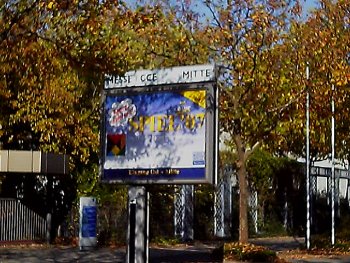 It looks just like the splendid weather we had last year would be repeated, but the forecast for Germany tells about a heavy weather change tomorrow, so that we will have heavy rainfall and good weather to stay at some indoor places.  Entering the convention area at about 2 PM, there was already good traffic caused by smaller and bigger lorries ariving from all over Germany and carrying the new games to be presented in the days to come. To guaratee a fast unloading of the trucks and their removal from the convention area (which otherwise would be overcrowded with trucks), the guards at the entries take a high deposit from any driver who wants to enter the area. If the truck does not leave within 30 minutes (or an hour), the deposit will be forfeit. Thus, people unload their vehicles in a hurry to leave the convention area again within the fixed time. 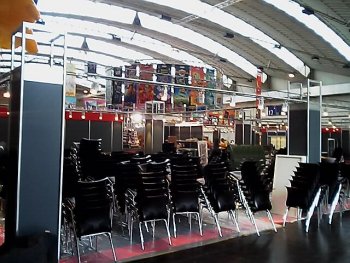 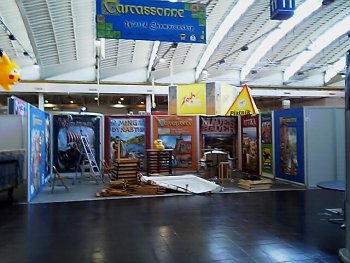  Taking the entrance of hall 11, I first entered the area where most of the major publishers will be entertaining quite big boths with ample space for lots of playtesting tables. As usual, most of the major publishers already had their booths prepared on this morning, so that work in these halls had progressed quite well.  Still, the organisation of a fair and the timely presentation of new games is pretty much a matter of timing, and at the construction site which is going to be the DAYS OF WONDER booth I met a press representative who told me that the new Memoir 44 Airpack has barely made it to the convention. In fact, the first few boxes arrived just yesterday, so that a limited quantity of the pack will be available for presentations at the booth.   Likewise, there was also some buzz before the convention which new games from QUEEN GAMES actually would be ready for presentation here at Essen, but looking at the prominent wallpapers at the QUEEN booth it looks like both major news would make it here: Eketorp, a game about the siege of a Viking settlement, and Giganten der Lüfte, a game about the golden age of dirigibles. 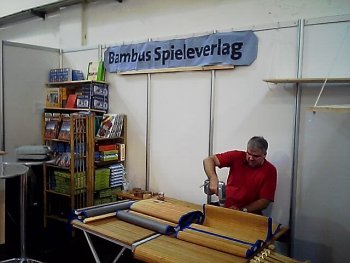 One hall later, I met Günther Cornett from BAMBUS SPIELEVERLAG. He told me that there had been some delay with the final production run of his new game Down Under so that he only has 100 small preview-copies of the game available here at Essen. Still, these samm sets are for sale, and to allow a good presentation of the prototype Günther was busy mounting wall covers with srews on which the playing pieces could be hung so that the game could be played on the wall. Well, he just had started, so he still had tho do several hundred screws this afternoon. Lucky that he had an electric screwdriver... 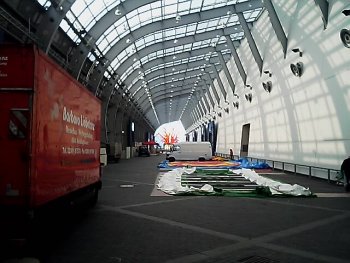 Continuing my first stroll through the Halls, I came to a gate which had not been open in the previous years. Stepping through, I came into the Galeria, a part of the Convention Center which so far had not been included for the SPIEL. However, as it seems, the SPIEL has grown again, and thus the Galeria for the first time has been included. I guess I will hear a bit more about the number of exhibitors at the press conference tomorrow.  Leaving the Galeria, I came to another area which was crowded as usual. The traders at the used games section all were busy setting up their booths, and hundreds of big boxes containing uncountable amounts of used games were opened, emptied and stowed away. However, having a look over the games for sale, my observations from the last years seem to have confirmed themselves. Thus, the most wanted titles even from recent years have nearly vanished from the shelves, and it seems that these games simply fetch better prices at Ebay than at the SPIEL. The games for offer here are meant for purchase by occasional gamers and not by collectors.  In the used games section I also met some familiar faces: Christian Leonhard, Ben Baldenza (a comittee member of the International Gamers Awards) and Rick Soued and his wife from FUNAGAIN GAMES. Talking to Rick, I got the disappointing news that the new edition of this year's IGA-Winner Through the Ages has not been finished in time to be presented at Essen. Thus, the 2500 copies of the game will be available in a couple of weeks on normal order from FUNAGAIN GAMES. Being somewhat of a legal successor to EAGLE GAMES, Funagain has come to Essen with quite a lot of boxes containing leftover copies of older EGLE GAMES titles. Thus, amongst other titles they have brought with them about 400 boxes of the German edition of Conquest of the Empire, and about 100 french boxes of the same game. 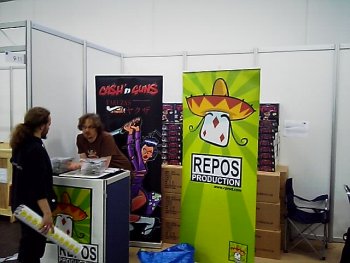 Passing a freshly arrived car from Belgium, I recognized the people of REPOS PRODUCTION. After their initial success with the great interactive party-game Ca$h'n Guns (my Convention-Hit in 2005), they now have finished the new Yakuza-expansion for the game. Featuring Shurikens and Tantos (short swords) and a Shotgun, the game now can be played with up to 9 players, and players who buy one of the 500 special edition expansions here at Essen will receive an Uzi automatic gun as a bonus. 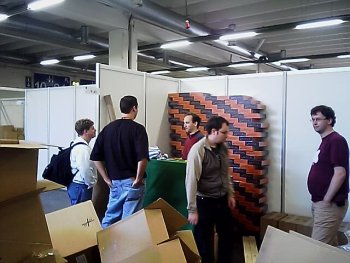 Rounding a final corner, I came to the booth of LOOKOUT GAMES and found Uwe Rosenberg already busy selling the first copies of his new game Agricola. Uwe has come to Essen with about 1000 copies of the game, and as he told me he has a good amount of pre-convention reservations. Anyway, the game looks interesting and the boxes are so full of playing material that they are rather heavy. I think many of you are eager to know a bit more about the game, and I am sure I am going to give you some details on one of the following days. 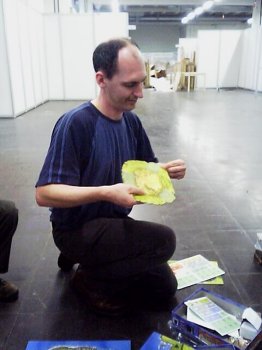 Coming finally to the booth of FRAGOR GAMES, I found the Lamont family in devout silence while unpacking the first copy of their new game Antler Island. Since they had not seen the final production run yet, Fraser Lamont was eagerly checking all the components of the box whether anything was missing on the final prints. However, with visible delight, he anounced that the game was complete! (Now the other 2499 copies of the game just need to be complete as well...) Also, despite the increased edition of 2500 games, FRAGOR once again had a good amount of over 700 pre-orders for the game. 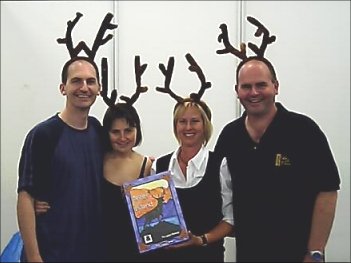 However, the Lamonts are not the only people who have taken a long road to Essen (although the way from Scotland has visibly left its mark on them). While preparing for this year's reports, I met Trond Meistad from Norway who had come to Essen with 28 (!!!) fellow gamers. He has told me the story of his last voyage, and I found the description of his journey so interesting that I have posted it here for you to read. So, if you want to know how 28 gamers come from Norway to Essen, go ahead and read Trond Meistad's voyage report! And reaching the end of my report for today, those of you who will have followed my Essen gibberish in the past years will know what is missing: The annual Prize-Draw!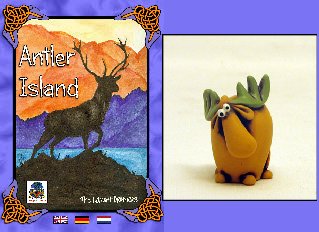 This year, the Lamont family has sponsored a copy of their brand-new game Antler Island all you have to do to enter the prize-draw is to sign the SPIEL Guestbook ! However, this year you have a bonus chance! So, if you do have some fond Essen-memories or SPIEL-stories you might to share, mail them to me at Kulkmann@aol.com during the convention and I will post them just like I posted Trond Meistand's story. If you send me a story, you will have an additional lot in the lottery when the winner of the prize-draw is drawn. Some more prizes may come in the following days, but it depends on what I am going to dig up. For now, I thank you for coming back to read this year's reports, and hope to see you here again in a day's time... Wednesday, 17th of OctoberWell, and here we are again, getting slowly closer to the opening day... Like usual on Wednesday morning, I went into the convention halls a few hours before the press conference takes place. As a matter of fact, it just is a great feeling to stroll a bit through the nearly empty halls, and it definitely helps to locate the booths of companies I want to visit later on. When the convention has opened and the crowds are in, it is sometimes a bit difficult to locate some of the smaller booths, and so it is a nice opportunity to find everything before the show has started. 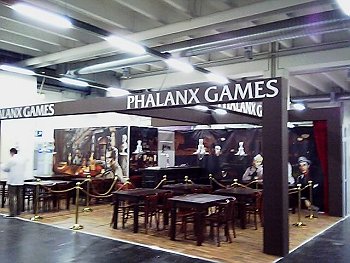  Going up to the Gallery and entering the Press Conference, I got the impression that press attendance was even bigger than the years before. This might be due to the fact that the SPIEL celebrates its 25th Anniversary this year, and probably such a jubilee is causing some extra attendants. 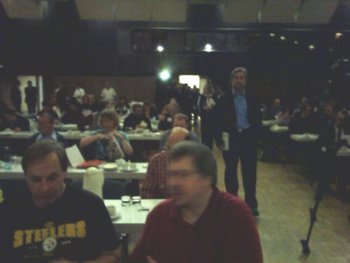 Mrs. Metzler from the Merz-Verlag, the organisator of the convention, opened the conference as expected with a view back on 25 years of conventions, and in a short video clip the great story of the SPIEL was recapitulated. Thus, the first SPIEL took place in 1983 in the adult education center here at Essen, and a total of 700 people and 12 publishers had announced that they would be attend this meeting. However, the organisators were surprised when over 5000 people appeared, and in the following year the attendance already had risen to over 15.000 people. And keep in mind, this was well before the time of internet media! 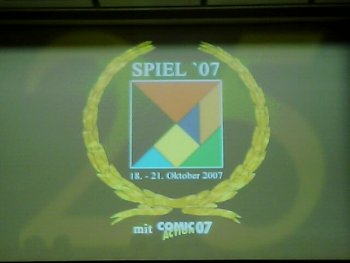 To keep up with the visitors, the city of Essen and the Messe Essen made it possible for the SPIEL to move into the convention area in 1985, and together with this move come a steady increase of visitors in the following years. So, there were 45.000 visitors in 1986, 60.000 people in 1987, and the 100.000 visitors mark was first breached in 1990, a year with already370 participating exhibitors. Being originally intended as a specialist meeting for interested gamers, the games publishers first had expressed their doubts whether such a convention would find public interest at large. However, the Merz-Verlag soon proved that the publishers were wrong, and especially the concept of the late SPIEL-founder Friedhelm Merz to offer affordable booths to smaller publishers has brought much movement into the games market since the typical dependence from the general trade had been broken by giving the small companies a possibility to directly sale their small editions to the public. Well-know German companies like HANS IM GLÜCK had started with small booths at the SPIEL, and today even foreign publishers like WINSOME GAMES admit that their sales here at Essen are better than at any other consumer show. Talking about the SPIEL today, there is a new record of 758 exhibitors coming from 30 nations, and 39 percent of these publishers actually come from foreign countries. The convention area has grown to a total of 44.000 square meters, and over 500 new games are waiting for the public to test them thoroughly.  With this statement on bare numbers, Mrs. Metzler handed over the microphone to Mr. Pohle, representative of the Fachgruppe Spiel of the German Toys Industry. He pointed out at board- and cardgames still make up about 18 percent of the toys offered here in Germany, and asked for modern trends on the games market he gave the answer that the only "trend" which could really be found is that diversity still rules the games market. There are games for everyone, and the games industry still is thriving even though it always had been asked in the last 15 years whether traditional games would not be weakened by modern computer games. Well, it seems that our hobby still has a future, doesn't it? Anyhow, with the hopeful words the press conference came to its end, and so I went over to the now opened newsroom where all the new games were presented to the press. As always, this newsshow is a great opportunity to take some pictures without the crowds pushing in from all sides, and it is also a great possibility to talk to the one or other publisher without having made an appointment. 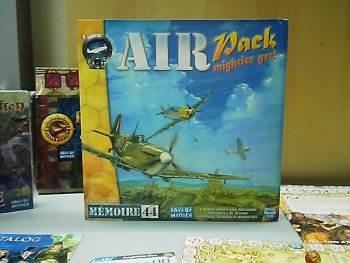 And here it was, standing pristine and innocently amongst the other products: The brand-new Memoir 44 Airpack, an expansion I have been waiting to see for a long time. As a matter of fact, my wife and I are running something like a Tournament of Memoir 44, going through about 50 scenarios in historical order and giving points for battles won on in each major theater of the war. However, when hearing about the upcoming release, we stopped our campaign to add the new rules and airplanes, and now I am hopeful to see that we might be able to continue our campaign soon. 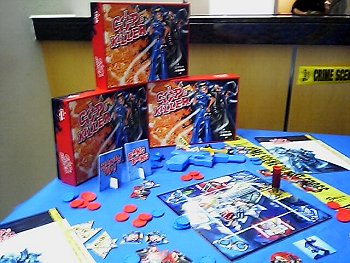 Another game which I will tell you a bit more about on one of the days to come is Cop & Killer. Introduced as a prototype by the small publisher GAMEHEADS at the SPIEL 06, the game which uses a dartgun on a crime investigation finally has made it into production. I told you about the prototype last year, and now it will be interesting to see how the game has developed. 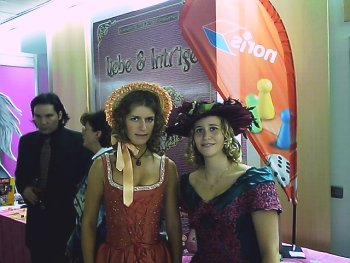 Finally, I had a small chat with two charming young ladies who were presenting their first game at the newsshow: Kira Verena Samol and Ellen Maria Ernst were present at the GOLDSIEBER arcade, and here they were explaining some basics of their new game Liebe & Intrige. Already the pink colouring of the bookcase-gamebox and the topic of the game (finding fitting husbands for the player's daughters) suggests that this new title must be some sort of a "woman's game", and the two authors confessed that they were quite taken by films based on Jane Austen books. They always thought it a pity that no nice games with slightly feminine topics were made these days, and thus, upon one evening at a pub, they decided that the time was ripe to publish a game of their own. I must confess that the whole background sounds intriguing for me, and thus I am sure I will give you some details on this game during the convention.  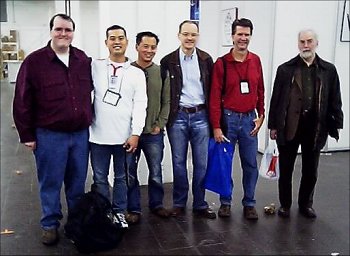 Later on, I finally stumbled upon some more IGA members having freshly arrived here at Essen. So, I found our committee President Greg Schloesser and Stuart Dagger, Greg's friend James Miller and also Dale Yu from Boardgamenews. All of them were just having their first stroll trough the convention halls, buying some games they had reserved and looking for other people who might have arrived. 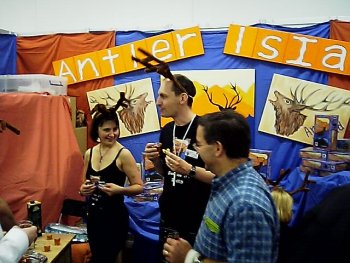 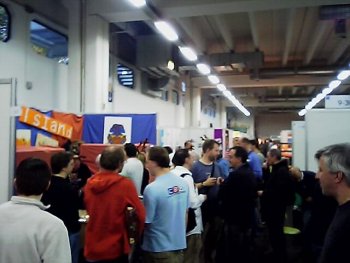 However, some things never change, and one of these things is the almost traditional annual reception which takes place at the FRAGOR booth on Wednesday afternoon at 4 PM. As might be guessed, the Lamont brothers had invided quite a few people to celebrate the release of Antler Island with a glass of Stag's Breath liqueur and Scottish Shortbread, and thus I was able to spend another nice hour, talking to Stuart Dagger and also Mke Siggins who had arrived together with Richard Breese just this morning. 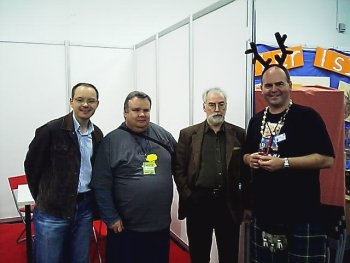 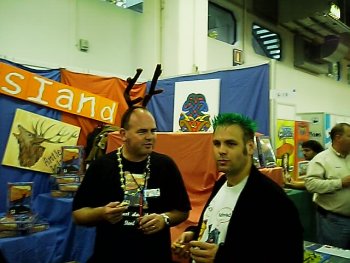 The antlers which the Lamonts had grown yesterday had not disappeared but seem to have grown a bit overnight, but even this frightening view did not prevent some other people coming by to join in with the celebration. Amongst these people also was Friedemann Friese, and he invited me to come to his booth one of these days to test his new cardgame Filou which is a bidding game in which the players trying to acquire some well-mannered, cute kittens instead of malicious rascals which like to use their claws. Sounds strange? Well, we will see… 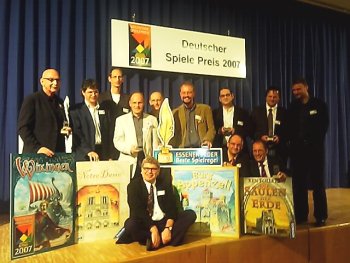 Finally, after a short trip home for changing into somewhat more formal clothes, I returned to the convention area at about 7 PM to attend the awards ceremonies for the 2007 Deutscher Spielepreis Awards. In difference to the "Spiel des Jahres" which is awarded by a rather small jury composed mostly of free journalists in a conclave meeting, the Deutscher Spielepreis is awarded upon a large voting of informed journalists, gamers and hobbyists. So, the KOSMOS-game Die Säulen der Erde which had totally missed a nomination for this year's "Spiel des Jahres" now was given its deserved treatment by the seemingly much better informed audience of hobbyists and had received the first rank in this year's Deutscher Spielepreis awards. To me, it is a riddle how the jury for the "Spiel des Jahres" could have totally missed this game which was received so well by the public, but it was somewhat satisfying to see that the voting mechanism for the Deutscher Spielepreis seems to egalize past injustice. Here is the final ranking of this year's awards:
 The Deutscher Spielepreis fort he Best Childrens Game and also the Essener Feder for the best-understandable rules both were awarded to Burg Appenzell from ZOCH. During the following dinner, I had the luck to be placed next to a representative of GAMES WORKSHOP, and thus I could flood the poor guy with a highly enjoyable discussion about some older GAMES WORKSHOP games and the way the company had changed over the years. For a company like GW, the whole perspective of the convention is much different, since they actually can man their booth with learned staff from the eight shops which GW maintains just in the Ruhrgebiet. This is very different from many other publishers who have to rely on solid hobbyists to explain their games, but it is also a sign for the high degree of attendance a "global player" like GW receives at such a convention. I couldn't resist asking about the future of Talisman which was just released as a first edition, and I will perhaps be able to give you some more details on the future of the game in a day or two when some GW staff from England have arrived… Well, that should be all for today. Tomorrow there will be some games to test… Thursday, 18th of OctoberHello everybody ! And here we are, finally having reached the first public opening day of the SPIEL 2007! 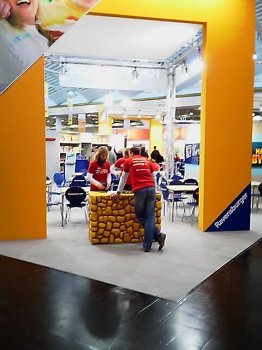 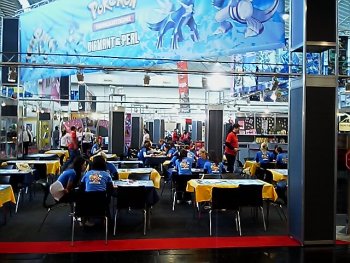 Having entered a bit early, I still could witness some of the major companies giving out last minute game instructions to the fair hostesses working at the booths, and in these last few minutes there was a buzzing everywhere of games being set up and people taking their places. 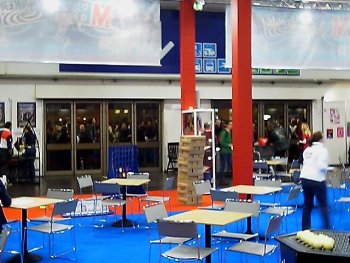 And then, on time at 10 AM, the guards finally opened the doors were a lot of people was crowding outside. Once opened, the people quickly flooded through the convention halls, and it was good to see that the tide of people was numerous as ever. Today, this is really worth noticing, since the Engineers of the German Railroad actually are on strike and were not operating any regional traffic between Essen and the other cities of the Ruhrgebiet. Still, Thursday always is a bit less crowded than the other three days, and thus I was looking forwards to some nice playtesting today. The first booth I chose to visit this morning was the French publisher MATAGOT which had some success with the time-travelling game Chronos in 2006. This year, the have come to Essen with their new game Utopia, and already looking at the nice artwork on gamebox and board and the plastic playing pieces has left me some appetite to go into a playtest. 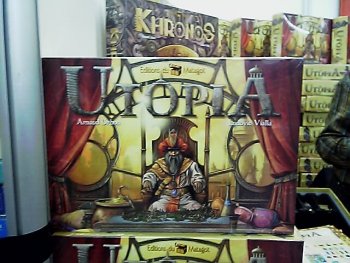 In the game Utopia the ruler of an island has invited the five great ancient nations of the Romans, Egypts, Persians, Chinese and Incas to come to his empire to build beautiful monuments within the different quarters of the capital city. Thus, at the beginning of each turn, a number of visitor tokens is randomly drawn and assigned to the four different quarters of the city. The players who have assumed the roles of counsellors in turn may chose one of these visitors, replace the marker with a fitting marker from their own stockpile and place the visitor within one of the districts of the quarter. Following this procedure, more and more visitors arrive and start crowding the districts all over the town. The players have two different options to build: on the one hand, they can try to get three of their visitors which come from the same nation into one district. If a player succeeds in doing so, he may remove his three counters and replace them with a monument corresponding to the nation of the counters which were removed. At the end of each turn, a player who has erected one or more of these monuments will receive victory points for them, but this will not be a fixed sum but depends on how the nation from which the monument was built stands in the regard of the island's ruler at that moment. Thus, there is a ranking list on one side of the gameboard, and the monuments from the nation on top of the ranking list are worth one victory point each, whereas the monuments of the nation on the bottom of the list only score one victory point. However, the building of a monument is not the only possibility to score victory points, and so the first player who succeeds to get visitors from all five nations into one quarter may remove his five visitors and replace them with a World Wonder. This special building is placed at the center of the quarter, and from that time on the player will receive some victory points whenever any monument is finished within that quarter. Thus, the early possession of a World Wonder is rather important, since is generates victory points till late in the game. However, the landing of new visitors and the building of monuments and actions is not all that is done by the players. Each turn, the players receive a number of playing cards, with the current leader in victory points receiving two cards less than the last player. The cards also show one of the five nations of visitors, and they may be used for a number of actions. Thus, three cards of a kind may be used to add an additional visitor of that nationality anywhere on the gameboard, whereas one card alone just may be used to add such a visitor on a space which contains a monument from that visitor's nation. If that monument actually belongs to another player, that player will receive a victory point for allowing the recruitment of a visitor. Likewise, a single card also may be used to move one or two visitors from a nation, and thus the visitors on the board are not stationary but the player may try to move them between the districts or even into different quarters to get into position for erecting new monuments or World Wonders. Also, a player also may use a card to remove a visitor from the board if he is standing at the monument of his nation, and this in turn will give the player an additional victory point. However, very important is the fact that the cards also may be used to change the positions of the different nations on the ruler's ranking list. Thus, the playing of one card causes the corresponding nation to go up one space on the monarch's esteem (changing places with the nation which was occupying this level), whereas the playing of two matching cards actually allows to move one of the nations down to the bottom of the ranking list. This way, the value of the different monuments by the end of the turn can be influenced, and the players will try to get the nations from which they possess monuments higher in the esteem of the island's ruler. 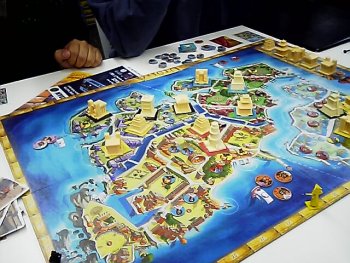 The game ended after one player successfully gathered 50 victory points, and although gameplay progressed smoothly once some initial questions were cleared, I somehow never felt that I was in full control of the things happening at the gameboard. I clearly won the four-player testing round in which I participated due to possessing two of the four possible World Wonders, but I could observe that much depended on which cards I was dealt. I was lucky and got really useful combinations of nationalities, but to my mind this resulted in a rather unforeseeable game. In a way, I only reacted from turn to turn, and even during the turns I had so many playing options that it was a bit difficult to decide where I should actually focus my actions on. While I am certain that these effects would lessen with repeated play, I still think that the luck factor is too high for a strategic placement game. However, I had not lost my taste to try even more games from smaller publishers, and thus I went into the Gallery to visit the booth of the Finnish company TUONELA which was present for the first time here at Essen. 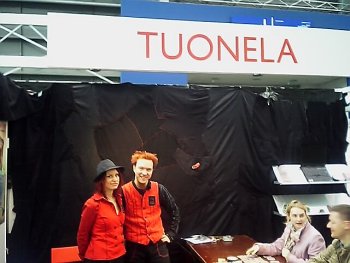 As TUNELA's game designer Jussi Autio told me, the word "tuonela" in Finnish mystic describes the place where the Dead go, and they had chosen it as a name for their company because they have the ambition to produce some games from "another world". Well, with these high aims stated, I simply had to sit down to get an explanation of the biggest prototype game they had brought with them to Essen… The game Modern Society is a reflection of the four greatest challenges pulling influencing the development of mankind in modern times. Thus, the gameboard features four tracks which represent Militarism, Economy, Human Values and Green Values. At the beginning of the game, the indicators for all four of these challenges start at the middle of each track, giving each of them a basic value of "1". However, as might be guessed, the indicators do not remain stationary, but instead the players will receive a hand of cards which they may use in the coming four turns to influence the positions of the indicators on the tracks. 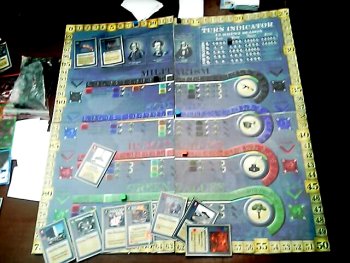 Each of the playing cards in the game features some artwork and text relating to news headlines in the last few years, and most of these events have an influence on one or more of the indicators on the tracks. Thus, for example "War in Iraq" will lead to a rise of Militarism, while at the same time causing a decline of Human Values. Also, most of the playing cards also allow the players to make one or more scorings on one of the tracks, and whenever a player makes a scoring he will receive victory points depending on the current positioning of the indicator on the track. So, after some rounds there might have been a considerable rise in Militarism, and when a player now makes a scoring for Militarism it will be more valuable than if the indicator had remained on the middle of the track. Likewise, indicators also may be on the lower half of the track, and if such a challenge is scored the player correspondingly receives less victory points. A special phase takes place every time each of the players has played a certain amount of turns. In this interlude-phase, the current standings of the indicators will be reviewed, and following some easy colour-coding on the gameboard an extraordinary positioning of one of the indicators may result in an additional rise or decline of other indicators so that the challenges slowly will shift and with them the general attitude of the modern society reflected in the game. At this point, an interesting observation on the fact of how well the game captures a fraction of real life could be made, since it is somewhat frightening to see how certain events could influence not only politics but actually much deeper values. Of course, the scope of a game never can be big enough to give a full reflection of all interrelations, and certainly some of the events depicted on the cards in the game are interpreted very narrowly and one-sidedly due to gaming reasons. Still, it was fascinating to see the different indicators on the board being moved by different events, and it is certainly a rather interesting idea to turn the whole topic into a game in which the players try to profit from certain developments in society. I will not go deeper into the game's mechanics at this place, but just mention a few additional facts which actually illustrate how far this prototype has been developed. So, there is the possibility that "Law"-cards will change some rules of the game as a reaction to some events, and also, despite the fact that often the cards in the game are randomly drawn, there still is some control for the players added by a "draw and discard excess cards" mechanism. Quite importantly, I got the impression that the randomly dealt hand of cards from the beginning could slowly be developed by taking future card-combinations into consideration, and so the game comes with a strategic angle that gives the players a few planning options and does not simply focus on reactive, turn-by-turn play. In this context, the prototype of Modern Society seemed to be more developed than the already available Utopia which I played just before. With this promising start, I hope that Jussi and his crew will find a distributor willing to take the game into its program. A few fine-tunings possibly need to be made, but the game offers an interesting simulation of modern life which is quite unusual for a boardgame. Greetings to Finland, you have a nice strategy game brewing up there in the North of Europe! 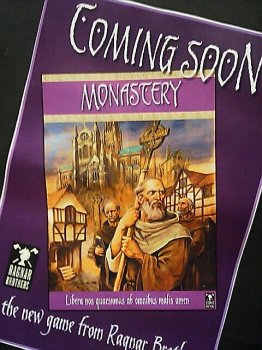 On my way back to the main halls, I made s short stop at the booth of RAGNAR BROTHERS. They had announced that their new game Monastry would be launched here at Essen, but unfortunately the artist had broken his arm and thus the artwork for the game could not be finished. Thus, neither the finished game nor a prototype is available for the SPIEL, and all everybody interested in the new RAGNAR game will have to wait till 2008 before it becomes available. 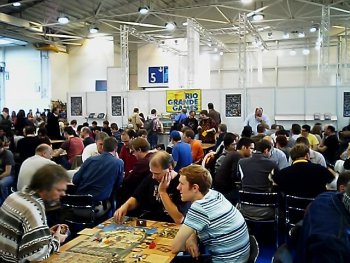 Back the main halls, I found that they have become moderately crowded, but it was still plenty of place to be found for doing some gametesting. I went to the booth of HURRICANE GAMES to have a look at the new Mr. Jack expansion, but I found that they were still waiting for the final version of the game to arrive. However, HURRICANE GAMES share their booth with a small Swiss company called GAMEWORKS, and they have brought with them a wonderfully illustrated cardgame which directly tempted me to go for a testing round. 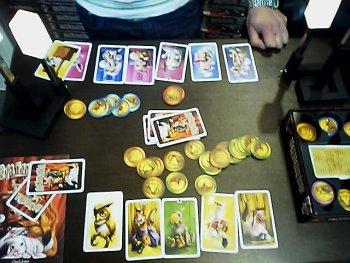 The small cardgame Animalia for two to six players actually started as a commercial article by the Swiss Insurance Company 'Assura' to promote their new insurance for pets, but instead of doing a pure merchandising article the company wanted to put out a real game without any reference to insurances, and they even got Bruno Cathala to co-author the game. The rules of gameplay are rather easy to grasp. In the game, four different kinds of animals exist (Dogs, Cats, Horses, Parrots). Each deck of animals consists of seven cards, and during his turn the active player turns around the topmost card of the random deck, reveals it and decided whether he wants to keep the animal for his own collection or whether he wants to pass the cards to his left neighbour. If kept, the card is placed in front of the player, but if he rejects it is now up to his neighbour to keep the card or to give it just to the next player in the line. This continues until the card is taken by a player, or returns to the active player who then has to add an additional card to the first one from the drawing pile and then once again has to decide whether to pass or keep these cards. Following this process, up to three cards may be passed around the table and rejected, but if the collection of three cards returns to the active player he will have to keep them for good. On which grounds does a player decide which cards he wants to keep? Easy enough, he will need to get animals of the same kind. In total, each player will collect a total of 5 animal cards, and after all players have their five cards they will score victory points according to the animals they have collected. So, a single animal does not count for any victory points, but the possession of two ore more animals of the same kind gives the player one victory point for each animal in this group. The players receive victory point markers of the colours corresponding to their animals which they keep face down in front of themselves. Handing back all their animals, another round of collecting starts in which the players once again try to get animals and score victory points once everybody has 5 animals. After the evaluation, the third and final round starts, and after the evaluation following the third round all players will reveal their victory point markers. Now the players will have to check whether they were able to collect five victory points of a colour, and for each five victory points of one colour they will receive an additional five victory points as a bonus. However, some more spice is added by the special options connected with some of the cards. So, there are some rather beautiful star-rated animals which pass as the 'stars' of a player's collection, and the player with the most stars at the end of a round may draw 2 additional cards which he may try to improve his collection by replacing one or two of his animals to get more valuable combinations. Also included are three animals allowing actions, and these are the Thief, the Spy and the Rascal. A player needs to action cards of the same type but of different animals to use such an action, and whereas the Thief allows the player to steal a card from an opponent, the Rascal will give the player a possibility to bestow one of his animals on another player (who will probably have no need for it). The Spy on the other hand allows the player to check the top five cards of the drawing pile and to arrange them in any way he likes. Animalia is a cute little cardgame with not too many strategic implications. Play progresses fast without the players being held up by long phases of decision making, and to my mind this light-going cardgame is just the right ending for an evening which had begun with a longer boardgame. The artwork on the cards is marvellous, picturing an impressive collection of hilarious animals, and together with the fats-paced rules the game certainly forms the high-quality to which modern cardgames can be developed. As announced on Tuesday, I did not want to miss Uwe Rosenberg's new game Agricola this year, and thus I turned my feet towards the booth of LOOKOUT GAMES where I found that already a good number of Agricola had been sold. 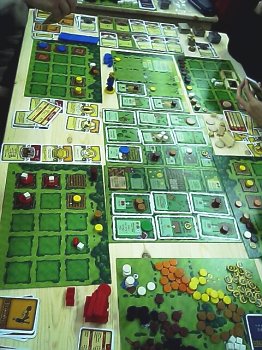 As the name of the game suggests, in the game the players take the roles of farmers in the 17th century. Each player possesses his own homestead consisting of 15 spaces, and at the beginning of the game two of these spaces are covered with clay buildings, each housing one of the two members of the player's family. The game is played in 14 turns, and during each turn a player sends his two family members to perform different actions. Thus, he may take new grain or vegetables as seeds, build new buildings or stables, plow and sow new fields or take some resources (clay, wood, reed) or animals (sheep, boars and cattle). Also, there exists an action which allows a player to add one member to his family if he should possess an empty building. The interesting twist about the different actions available to the players is that only a few basic actions may be chosen at the beginning of the game. Each turn, a new action card is revealed, opening new possibilities to the players, and since each action may only be chosen by one family member each turn the players he to decide well which actions they should chose. As indicated, most actions lead to some changes on a player's homestead board, so that new buildings may be added, fields may grow and corrals with animals come into existence. After the end of specific turns (six times during the game), a special harvest round takes place. At this time, the players are allowed to harvest the plants which have grown on their fields and to multiply their cattle in the corrals. However, the time of harvest also is the time when the players' families have to receive their nourishment, and for this reason they may turn harvested grains and vegetables into nourishment counters. Two of these counters have to be spent for each family member, and if a player cannot pay this upkeep he will have to resort to begging which means a penalty at the end of the game. What makes each game of Agricola quite unique is the fact that the game includes 166 (!) Profession Cards and 136 cards depicting Small Purchases. In addition, also a deck of 10 fixed Major Purchases is included. A few of the Professions and Small Purchases are distributed amongst the players at the beginning of the game, and during the course of the game the players may chose actions and pay resources which allow them to play any of these cards. Each different Profession or Small Purchase has a different impact on the game, and with good combinations a player can get nice benefits on production, creation of nourishment markers etc. It is exactly these cards which add spice and flavour to the game because they are used to change the normal course of the game, but I have to confess that at the moment I am quite uncertain whether I really can grasp the full impact of most of these cards. As indicated, only a fraction of the full deck of cards will be included in each game, and since these cards are randomly dealt at the beginning of the game it is impossible to plan strategically on the appearance of any of these cards. Granted, both the deck of Professions and the Small Purchases deck are subdivided into three types of cards (Beginner, Interactive, Complex) and by choosing just one type of cards a certain pre-selection can be made, but at the same time the author also points out the possibility to mix cards from the different decks. As suggested by the names of the decks, the cards also create interaction between the players and there also exist nice possibilities to make combinations resulting in benefits during the game or in the final evaluation. The game ends after the Harvest-phase following turn 14, and then the players will receive victory points for their houses, family members, fields, animals, corrals, grain, vegetables and acquired cards. Having a closer look at the rulebook after coming home today, I was rather happy that I had the possibility that the game was explained to me at the convention. Although the body of the rules is not long and Uwe Rosenberg gives the players quite a lot of assistance for teaching the rules (including helpful sheets for layout and examples on the back of the players' homestead plans), the game does not seem easy to learn just from reading the rules. The available playing material is somewhat overwhelming, and due to the fact that a good amount of text is printed on the cards it will be even more difficult to get a start for players who are not firm with the German language. Even more, the need to get a full understanding of the Profession and Small Purchase cards requires the players to play the game a few times to get a grasp of what may happen during play. Afterwards, I guess that the players will be able to enjoy a nice, diversified game with many twists to explore, but I do not dare to predict within the scope of this convention report whether or not the game really can offer long-time fascination. It is difficult to guess whether the random availability of cards will be satisfying for gamers who normally like similar resource-management-games for their strategic options, and to my mind the random inclusion of these extra cards is a dangerous hazard for all strategic planning. 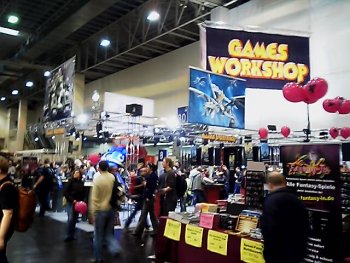 With day day coming towards its end, I made my way over to GAMES WORKSHOP where I was delighted to see that the freshly revied 4th edition of the classic fantasy boardgame Talisman had not only found its way here to Essen, but actually that GAMES WORKSHO and BLACK INDUSTRIES had decided to allow the new game some attention so that they gave Talisman its own playtesting area. It's good to know that boardgames still have a chance with such a tabletop-giant. 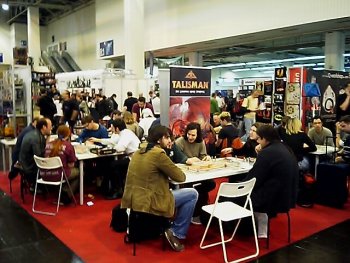 Anyhow, out of obscure sources, I somehow got access to three of the highly wanted "Arena"-Promo-cards which are quite hard to get by, and for this reason will will have an additional Talisman Promo Prize-Draw!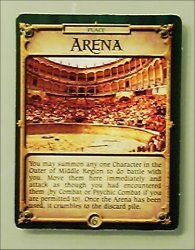 So, if you want to get one of these new cards, please send an email with the text "Talisman rules!" to my alternative email of brettspiel[at]aol[dot]com. And with this, I am signing off for today. 2:19 AM over here, rather late indeed... Friday, 19th of OctoberHi again everybody ! Another day of the SPIEL convention has passed (and also a good part of the following evening and night to get this report to all of you who have waited). It was a rather entertaining day at the convention, and so I will move straight to the daily news… First off I wanted to get seated on a table from ULYSSES, a German producer which is involved in the production and distribution of the Italian game Kingsburg here in Germany. I was lucky to get an early table, and thus I went straight for a playtest of the beautiful looking game. 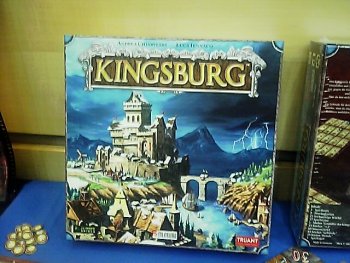 In Kingsburg, the players take the roles of local earls in a fantasy kingdom, and during the game they must try to collect victory points by constructing useful buildings in their counties and interacting with the different personalities at the court of the High King. The game is played over a duration of five rounds (years), and each year is split into a number of phases in which the players acquire resources and build. Thus, the game starts with the first phase of the first round, giving the player(s) with fewest buildings an additional dice for the following phase. In the first round, nobody possesses at building at this phase, so that nobody will benefit from this bonus. The next phase then is an interaction phase in which each of the players rolls his hand of three dice. The results of the dice rolled by each player are added up, and the player with the lowest result becomes the first player for the phase whereas the other players follow in the order of their results so that the player with the highest result gets to act last. In turn, the players now regard the 18 different characters of the King's Court which are printed on the gameboard, and using either the result of one of the dice or the combined result of two or three dice the players now may assign these dice to the character bearing the corresponding number. This way, all the players place their dice with one or more of the characters at the Court, observing the rule that no character may be approached by more than one player so that the more and more spaces become restricted to the placement of dice. In the end, this may result in some dice being not useable and thus lost for the players who have rolled them, unless they chose to combine them with some others of their dice to get a result which hopefully is still unoccupied. 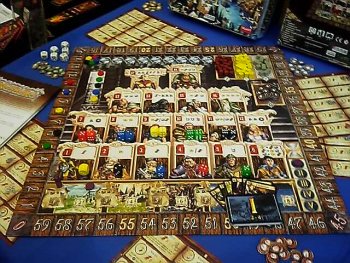 Starting with the lowest numbered character, the players who have placed dice on characters now make use of the characters' abilities. The higher the number of the character, the better are the benefits which the character has to offer, so that a player may only get one resource from one of the lower characters, whereas the King himself (space 18) grants a full set of the three resources Gold, Wood and Stone plus a Soldier. Also available are some other benefits like addition markers which may be used to improve a player's result during the next interaction phase or a sneak look at the War card which will be turned up and needs to be faced by the players by the end of the round. When all characters with dice on them have been evaluated, each player may use his resources to build a building, and the prices and abilities of each building are shown on the playing mats of each player. Five different categories of buildings exist, and in each category four different buildings may be built in increasing order and with increasing powers. The special powers of the buildings have considerable influence on the player's options, since they may provide extra defensive points, allow an increase of the roll of the dice in the interaction phase or even a complete re-roll, the easier recruitment of soldiers etc - the options are manifold. Also, most of the buildings provide one or more victory points for the player, and as long as he possesses the building he may advance his victory point marker on the track on the mainboard. Once the players had a possibility to build, the phase ends and the round continues. Two more interaction phases will take place in phases four and six of each round, and in the two intermediary phases before the players may get a small benefit depending on their current situation in the game. After phase six comes winter with phases seven and eight. In phase seven, players may use resources for recruiting additional Soldiers, before finally the War card for the current round will be turned over and needs to be faced by each of the players. For each round a separate stack of War cards exists, so that the value of the War card is not known before the eighth phase. However, the players know the approximate value of the strength of the card, and also that the general strength in most cases increases from turn to turn. Adding his number of Soldiers to a roll of the dice (representing the King's assistance), the players have to reach a value equal to the strength of the War card. The successful, the players will get a small bonus, whereas the unsuccessful players may loose some of their resources and possibly also one or more buildings. This way, the game continues with players erecting new buildings and gathering victory points, until the fifth and final round has been played. After the final War card, the victory point markers will be adjusted and the player with most points will have won the game. Although there are quite a lot of differences, I somehow had a feeling that Kingsburg is an improved version of Puerto Rico which had gone for a fantasy topic. I playtested it with just two players and the game's mechanics worked rather smoothly with both players being able to chose a good number of characters at the Kings Court and to add quite a few buildings to their counties. This may change with more players participating, but due to the number of available characters there should still be enough options left as to keep a player from falling behind to far. And, as a further barrier to falling too far behind, the intermediary phases reward the weaker players with a few small benefits which give them a chance to catch up again. There is an element of luck in the game since the players often resort to rolling their dice, but due to the fact that dice results can be combined the influence of luck is not really bothersome. What I really liked about Kingsburg was the fact that the rules are rather self-evident once a few phases have been played, and the colourful gameboard not only is really nice to look at but also is a perfect player help since all needed tracks for scores and game progression are included so that all information constantly is at hand in a very ordered way. A really nice game of resource management!  Do you know Knut the Polar Bear? A little Polar Bear baby was born in the Zoo of Berlin some time ago, and it seemed that for a long time the newspapers and television were full with images and reports about this cute little bear. With Zooloretto we now have a "Spiel des Jahres" featuring the management of a Zoo, and what would be more fitting than adding a nice Polar Bear Tile to the game? Thus, ABACUSSPIELE was handing out a one-tile mini expansion for Zooloretto, and of course I will add this cute little playing piece to the Prize Draw! So, don't forget to sign my if you have not already done so! Do you want to see something top secret? Well, then join me next on my visit to HASBRO, were I was planning to have a small chat about the progress the new PARKER series of author's games has made so far. As a matter of fact, the two first games Tal der Abenteuer and Origo had not fulfilled the expectations which were set into them, in case of Origo even missing the line of 2.500 copies to be sold in Germany. However, HASBRO still wants to invest more time to let the new series grow, and thus they will continue next year with a new game in the series. Even better, like last year I got the opportunity to get an exclusive look at the prototype of the new game, and who would not like to see a little bit of what a major publisher like HASBRO still might have in its pipeline? 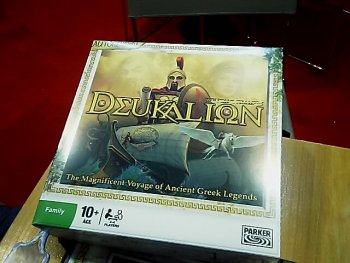 Next year's game probably will be published under the name Deukalion, and as the artwork on the box cover suggests it will be a game about Greek mythology. Having a great appetite for stories from that era, this sounds rather tempting for me, especially due to the fact that the last German games on the topic were Blitz und Donner by Richard Borg and Hellas by the late Franz Benno-Delonge which were both published as two player games by KOSMOS several years back. 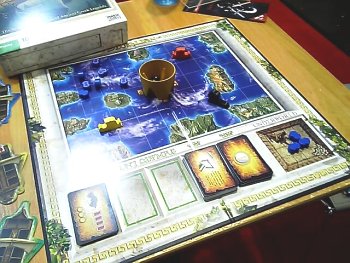 But now, Deukalion is coming, and in it the players man their ships to sail between the Greek Mediterranean Islands in search of Gold and Glory. The full set of rules was not available for the game, but I could deduct quite a lot from the playing pieces and cards which were available. So, the players get to draw mission cards which require them to visit certain islands with Hoplites (soldiers) or other items, and they will receive a reward for each such mission completed. Each of the players navigates a ship on the gameboard, but he also possesses a storage mat for the ship which on which the men and cargo can be placed on empty slots. The Hoplites may be used to do battle, and to determine the outcome of a battle the players actually will use the Hoplite playing pieces as dice. Depending on the side on which they land, they either remain alive or are forced to go down to Hades, but there seem to be some possibilities in the game which should allow the players to Hoplite-pieces from Hades. So some cards exist which allow the taking back of some pieces, and also the River Styx (border to the Underworld) can be found on the map, so that there is a probability that playing pieces might be gotten there as well. On the board, not only the player ships are moved, but also the Hydra as a dangerous sea monster. To determine the actions available to the active player, he takes up a special dice cup which he shakes. The five dice in the cup will settle down into small depressions, and then the cup is placed at the center of the gameboard where the player may turn it to align with several action symbols. He may not change the positioning of the dice in the cup, so that he will have to think which positioning of the cup would be most beneficial for him. That's actually all I could deduct from just examining the playing pieces, but I guess that the new game will be more complex than the first two games of the series. Also, the still unfinished artwork and playing pieces are looking quite promising, so that perhaps HASBRO finally might succeed in adding a highlight to its still young series. The only unfortunate fact is that there are still no plans for entering the US market with this series, but if there ever should be a real highlight enough public demand at least might lead to an English version for the European market. We will have to see... But now, let's quickly return to some more playtesting… 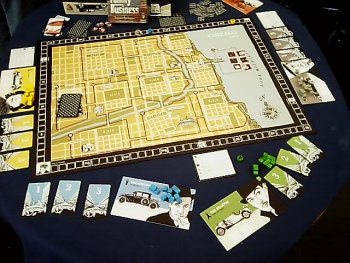 The new AMIGO-game Gangster by Thorsten Gimmler strongly reminded me of the SPIEL 2006. Not only because TUSBAS from Denmark had presented their gangster game King of Chicago at last year's SPIEL, but also because the name and the graphics by Robert Nippold which were used for this new product by AMIGO were actually identical to the Gangster game from LUDOART which I presented to you last year. However, gameplay in this new boardgame is much different, since now the players use cars to drive through downtown Chicago to place their Gangsters into the different quarters of the town. At the end of the game each quarter will be evaluated and the players will be assigned victory points according to their number of Gangsters, but these points change from quarter to quarter and sometimes it is better to have less Gangsters than other players in a quarter to score more victory points. The possibility to acquire enhancements like a Tommygun or a bodyguard and the modular mounting of the gameboard at the beginning of the game actually increase the entertainment and replay value of the game, and in comparison to King of Chicago the influence of luck is slightly less pronounced in Gangster. However, King of Chicago still has the upper hand concerning a more precise representation of the War for Chicago, and thus it is a matter of taste whether the one or the other should be preferred. But now, it was really time for the annual Friday-lunch-meeting of the members of the International Gamers Awards committee present here at Essen, and so I joined out team at the Restaurant for a nice hour of gaming chat. 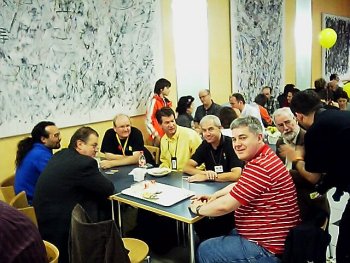 On the image, you see from left to right Andrea Ligabue from Italy, Ferdinand De Cassan from Austria, Ronald Hoekstra from the Netherlands, Greg Schloesser the the USA, Mik Svellov from Denmark, Alan How from England and Stuart Dagger from Scotland. Meeting only once a year at Essen, it is always a great time to exchange some views on the future development of the IGA, and it's also a nice possibility to hear which games still might be worth to look at. 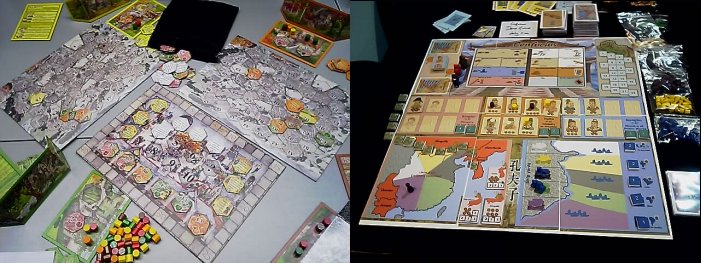 Strolling a bit amongst the booths of some smaller publishers after lunch, I saw that Richard Breese once again is back with a new addition to his series of "Key"-Games. So, this year the rather complex looking Key Harvest has joined the line. And on the next booth, SURPRISED STARE GAMES presented the prototype of their upcoming game Confucius.  Returning again to a major publisher, my wife actually asked me to have a closer look at the new GOLDSIEBER GAME Liebe & Intrige. The topic of getting a player's daughters married to Noblemen and the colour and design of playing pieces and gamebox clearly suggest that this game is meant for a female audience, but having seen movies like "Pride & Prejudice" or "Emma" I was rather curious how such a background could be transported into the scope of a boardgame. At the beginning of the game, each player randomly draws three of the 12 daughters available in the game. Keeping the cards faced-down, building a stack and turning the topmost daughter face-up, the players put attribute markers on the indicated three attribute scales on their daughter card. Each daughter has the attributes Reputation, Beauty and Prudence, and each of these attributes may vary between the values "0" and "5" during the game. Also, a stack of Bachelor cards is shuffled, and a certain number of face-down bachelor cards is assigned to five of the sixe different places on the gameboard (Theatre, Pub, Boulevard, Poorhouse and Park). Only the Tailoring does not receive any Bachelor cards. 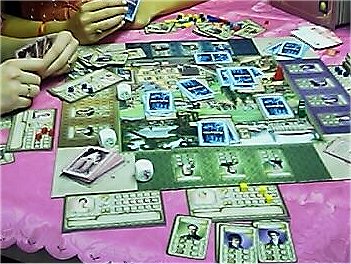 During his turn, a player moves a figure representing his daughter to one of the places on the gameboard, and at these places he first adjusts one or more of the attribute markers of his daughter as indicated on the board, corresponding to the influence that her presence at this specific place takes on the daughter's character. Next, the player takes up the stack of Bachelor cards assigned to this place, and then he must chose one of the available Bachelors and place is next to his daughter card. Six cards of each Bachelor exist in the game, and a daughter may collect as many cards of a Bachelor as the player can find, but a daughter may never have cards of more than three different bachelors aligned next to her card. So, if the player is forced to take the card of a fourth bachelor, he must discard the card(s) of another Bachelor of his choice. The stack of Bachelor cards at this place then is replenished with a new card from the drawing pile, and the player's turn then ends with the drawing of an Event card which the player takes to his hand. Each of the Bachelor's has quite specific notions on the attributes his future wife should possess, and to marry his daughter to a specific Bachelor a player needs to collect at least three cards of this Bachelor and the daughter's attribute need to be at least as high as listed on the Bachelor's card. If these pre-conditions can be met, a player can announce a marriage and marks the Bachelor off on the gameboard, collecting all present and future cards of the Bachelor since this character now is out of the game. After a successful marriage, the player turns over his next daughter and once again starts the search of a fitting groom. More spice comes into the game through the Event cards and a set of special dice. If a daughter visits the Pub or the Park, the player will have to roll a Casanova-dice which shows if Casanova is present. If he should be present, the dice also lists a number what a level of beauty the daughter must possess to be in danger of being approached of Casanova, but if he should take a liking in the daughter it will not be beneficial for her and she looses one point of Reputation. Likewise, the Pub also requires the roll of a Drink dice, and if the player is unlucky and rolls a bottle his daughter will have suffered an alcohol poisoning and looses one point of Prudence. Finally, the Intrigue dice allows a player to try to steal a card from an other player's daughter present at the same place. If the player spinning the intrigue is lucky and rolls a four leaf clover, he will be allowed to take a Bachelor card of his choice from the other player's daughter, but if the dice roll is not successful the other player turns the table and may chose one of the Bachelor cards from the unsuccessful schemer. The game ends when the first player succeeds to marry his third daughter. Now the players receive victory points corresponding to the values of the husbands they have found for their daughters, and further points are attributed to the players with most Reputation, Beauty and Prudence in their family. Finally, some bonus cards from the Event deck also give a few additional victory points, and all together the player with the highest total will have won the game. Although the rules can be read rather quickly and the options in the game are limited, I found that the background topic was reflected rather well with the players trying to bring their daughters to places where they can find suitable cards and increase the right attributes. Quite funny is the interrelation that the biggest choice of Bachelor cards can be found in the Pub, but although the players sometimes need to roll the special dice there are quite a few tactical decisions to be made. So, the question is whether to go for an early, undisputed marriage with an elderly gentleman, or whether to spend a bit of time to wait for some handsome Nobleman. The players will need to try to remember where certain cards can be found, and the rule that a player always must move his daughter playing piece at the beginning of his turn also keeps the players from just digging out useful cards from the same place on consecutive turns. In comparison to some other games I have played at the SPIEL 07 so far, this game definitely is a lighter strategy game, but keeping in mind that GOLDSIEBER usually does not produce highly pretentious specialist game I think that there still are enough options available for the players to keep the game highly entertaining. I guess that the extraordinary theme of the game certainly is going to cause some commotion on the games market, and keeping in mind that the two authors Ellen Maria Ernst and Kira Verena Samol have not produced a game before it must be granted that this premier piece works rather well indeed. The game will certainly find its audience, and I guess that it also will appear as a gift on some weddings taking place in the future. 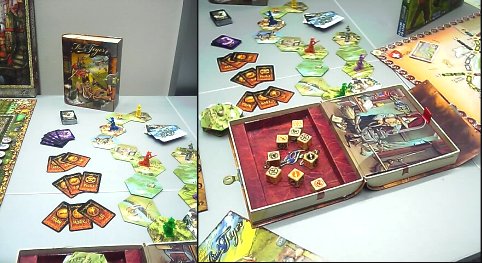 A family game which has received some attendance especially in France is the new PRO LUDO version of Flinke Feger, a game about some witches which have saddled their brooms for a race. Unlike the KOSMOS-game Zauberstauber which required the players to apply some 2-dimensional thinking to plot the courses of their brooms, the witches in Flinke Feger race along a fixed track of hex spaces. However, to get their movement allowance, the players first will have to roll a hand of 9 dice bearing magical symbols. They must try either to memorize the yellow or black symbols shown on the dice, and the first player who thinks that he has memorized the formula of symbols flips a cover over the dice and then needs to re-create the formula with his fixed deck of symbol cards. Only if he can re-create and read out the formula he will be allowed to move his broom forward. Among with some action cards which add some additional fun, the game seems to be a nice family game with an interesting twist of the players' memories (and their tongues when pronouncing the spells). Finally, the time had arrived for the ceremony of the International Gamers Awards 2007, and thus our team had arranged to meet at short before 5 PM at the booth of Czech Board Games. 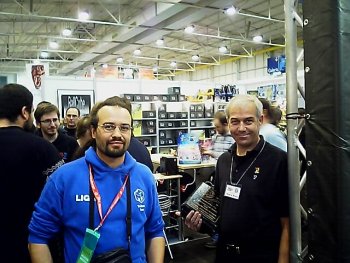 Andrea and Mik already had arrived, but actually quite a few other people seemed to have decided to come to our awards ceremony as well. 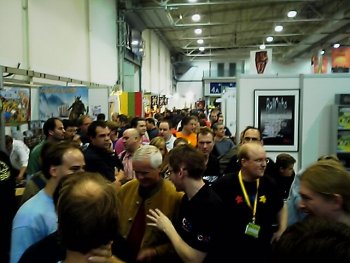 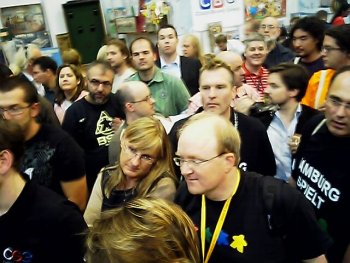 With CBG this year a small publisher had won the Multiplayer Awards, we so we had to conduct the gathering at a rather narrow passage close to their booth. 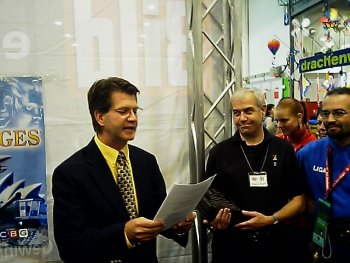 However, there was still enough space left, and so our chairman Greg soon started once again with one of his famous German-English laudation speeches. 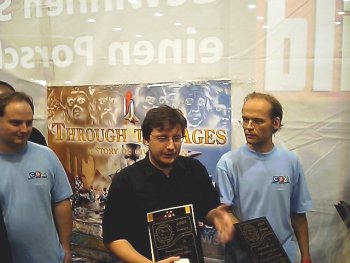 And then came, of course, the awards winners. First came the winners of the Multiplayer category, and Vladimir Chvatil (middle) together with the team of Czech Board Games was rather proud that their game Through the Ages for the first time brought a gamers awards to the Czech Republic. 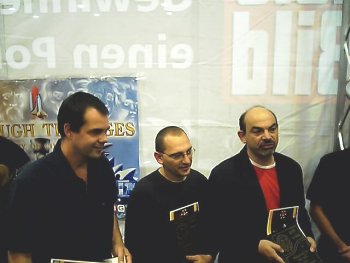 The awards in the Two Player category then was given the Mr. Jack, a game developed by Bruno Cathala and Ludovic Maublanc and published by the Swiss company HURRICANE GAMES. Yves Menu (left) came to represent the publisher, and of course the authors Ludovic Maublanc (middle) and Bruno Cathala (right) were present as well. And with these pictures, I will end my report for today. It's once again sleeping time ! See you tomorrow! Saturday, 20th of OctoberWell, its's Saturday, and already five days have passed. It seems that these convention days always pass aways like sand through my hands... But let's start right away!  Crowds and crowds of people! Already the entrances were blocked right from the beginning of this morning's opening time, and after thursday and friday actually were much less crowded than usual, today was a day of many people massing into the convention halls because of the weekend. 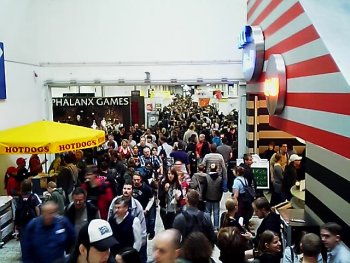 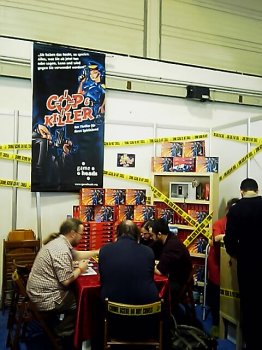 Being in the mood for an interactive starter at the morning, I came early to join a playtesting group for Cop & Killer. The game was presented as a prototype at the SPIEL 06, and once again it is a great experience to see how a game may evolve from a prototype to a finished product. Whereas the gameboard and playing components of the prototype still were hand-drawn and focused on the elements important for gameplay, the now finished game comes with some great artwork and nice playing components which could also have been produced by a major company and not just by a small publisher. But let's have a look at the game itself… Cop & Killer is an interactive game for up to 10 players, where the gameplay focuses on a Killer trying to kill his Target whereas the Cop tries to capture the Killer before he is successful. At the beginning of a round of play, each player randomly receives an identity marker which identifies him either as the Cop, the Killer, the Target or a Bystander. These identity badges are kept by the players in their hands under the table, and before the game starts the players may secretly exchange the badges so that nobody knows the identity of the others. To avoid looking at the badges while exchanging them, each type of badges has its own shape, so that the players know which badge they are holding without looking at it. 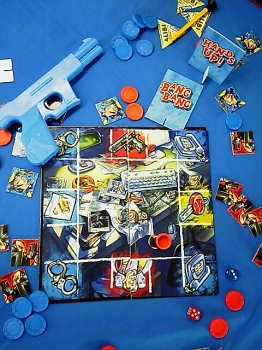 When the badges have been assigned by the players, the playing marker in form of a bullet is placed on the gameboard and playing commences. In turn, the players now roll a set of a red and a blue dice, and they may move the bullet clockwise around the board for a number of spaces corresponding to the number rolled with one of the dice. During the course of the game, the identities of the players may be revealed, and when this has happened to Cop, Killer or Target their rules for using the dice will be slightly changed. So, the Cop now must use the blue dice and moves the bullet clockwise, but he may decide to move less spaces than rolled by the dice. The Killer on the other hand uses the red dice and must move the exact number of spaces, but he may chose to go clockwise or counter-clockwise. Finally, the Target may use the result of one or both dice and move the bullet clockwise around the board. On the gameboard, the players will encounter a number of spaces which allow them to perform an action, but before describing those actions let me say a little bit more about the mechanics of the gameboard. So, each action space either has a blue or red background colour, depending on whether the action is beneficial for the Cop or the Killer. A player who lands on such a space and performs the action afterwards takes a coin of the corresponding colour, representing either a reward for helping the Police or a bribe for helping the Killer. When the round ends, either the Cop or the Killer will have been successful, earning the player of Cop or Killer one victory point. However, in addition the two players (Bystanders) who helped the successful Cop or Killer most and earned most coins of the winning colour also will be awarded one victory point, and then a new round of play will start until all 10 victory points of either Cop or Killer have been distributed. At this place, it becomes important to notice that the gameboard is double sides and can be flipped from a side depicting the Cop's office to the Crime Scene and backwards. The side with the Cop's office shows more actions which are beneficial for the Cop and the players who have chosen to assist him, whereas the side of the Crime Scene features more red actions which can be used by the Killer and his henchmen. The change of both sides of the gameboard is triggered by one space on each side, featuring either a car key or an office key, and the player who move the bullet onto the corresponding space flips the gameboard over and receives a correspondingly coloured coin. The action blue spaces which are favourable for the Cop and his assisting players are the following:
On the other hand, the following red spaces are more useful for the Killer:
When Cop or Killer are revealed, they discard all coins they have collected during this round, since from now onwards they are pursuing their own aims which are not quite congruent with those of the Bystanders. However, until then they should collect coins and normal, and they possibly have the chance to put the other players onto a wrong track by the colour of coins they collect. Finally, there are also a blue and a red action space which lead to the climate of the round: the blue Arrest space and the red Assault space. For an Arrest, the identities of Cop and Killer must be revealed, whereas an Assault needs Killer and Target to be revealed. If the Cop or the Killer decide to act, two dice are rolled, and if the acting player (Cop in case of Arrest, Killer in case of Assault) rolls a higher result on his dice than on the other dice, he may shoot that number of arrows with the included Dartgun at a target marker which has been set up at a chosen distance. If one of the darts hits, the round is over and the shooting player and his two best assistants will have won, but if no hit was scored the game continues. However, if the shooting was successful and if, after the distribution of victory points, all ten victory points of one colour have been used up, the game ends and the player with most victory points will have won. Wow, this game plays astonishingly well, and the playing mechanism certainly is not just a vehicle which forms the background for some otherwise senseless dartgun shooting. Quite the opposite, the gameplay is quite multi-faceted and offers a good degree of playing depth which is somewhat counterbalanced by the interactive element of shooting. The guessing and deduction of the players starts at the end of a round when the identity markers have to be exchanged, since no player may keep the badge of Cop, Killer or Target for two consecutive rounds. Depending on the positioning of the players around the table, each player may make some first deductions on who might now have which identity badge. During the game itself, it will be especially the Bystanders who will try to spoil an early victory of Cop or Killer, since they first want to collect enough coins to participate in the distribution of victory points at the end of the round. So, it will always be a few players who want to move for ending the round, while the others want to postpone the inevitable end until the get into a better position themselves. For this reason, especially the Interrogation action is rather useful, since a player who is asked a question is bound to his answer on his following turn. This may lead to a considerable restriction of his actions, depending on the way a question is asked. The extensive care which was put into this game is reflected by the artwork, the components (including a very robust and seemingly durable dartgun from a German manufacture) and the body of the rules. Special provisions for only four players for teamplay with 7 to 10 players are included, as well as a full English version of the rules. Even the details are harmonious, with a real-looking bullet as a playing piece and a carboard-piece resembling a yellow "Police Line" which is used to mark off the line after which the shooter must stand. To my mind, Cop & Killerer is a really outstanding interactive group game, and with people who do not mind the somewhat violent topic really thrilling games should be possible. The however, a problem for the mass marketing of this game still will be the price, since the current final sales price of 45 Euros deinately is a bit too much for a game of this scope. 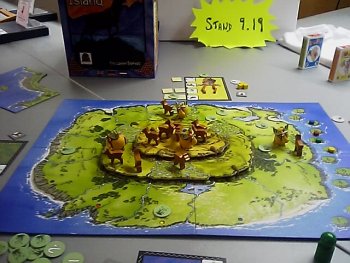 Also, I thought that the time had come to give Antler Island by Gordon and Frazer Lamont some testing. Being well known for their cute gaming pieces used in Shear Panic and Hameln, the Lamonts were faced with a problem at the production stage of the game when prices for their cute Stag playing pieces went up so high that they had to increase the edition-size of their game to 2500 pieces. Revealing this fact openly and giving all people who had placed a pre-order a chance to withdraw this order, they still came to Essen with a good rate of over 700 games still on reservation for being picked up here at Essen. Already upon opening the gamebox I could discover that this game is much different than Hameln last year, since the gameboard for Antler Island was not made on a computer but actually drawn by a professional artist. The gameboard shows and island with a raised inner region, and the inner region in turn is crowned with an additionally rised peak. At the beginning of the game, each player puts his Stag playing piece at a colour coded space on the island's outer region, while some Does and Food tokens are evenly distributed amongst the other spaces of the island. The only exception are three swampland spaces on the middle region and the peak space at the center which are left empty of Food and Does. During a round of the game, the players first have to plot the four actions which they want to perform during the round. To plan their actions, the players have five markers bearing the numbers from "1" to "3", an "X" and an empty marker which they may secretly assign to any of the four possible types of action listed on their player sheets. The possible types of action are the movement of he player's Stag by one space, the eating of the food tokens from a currently occupied space, the mating with a Doe on the same space or the growing of Antlers. However, the players doe not act simultaneously, but instead they start with the starting player who first has to reveal his "1" marker in order to perform the action he has assigned the marker to. Then the other players reveal their "1" markers in turn, also performing the actions they have chosen with their markers. The empty marker may be used for bluffing, although it is considered to be bad sportsmanship to look at another player's placement of markers before placing his own markers. The "X" marker on the other hand is some sort of a joker, and a player always may chose to reveal his "X" marker instead of one of his numbered markers to perform the action he had associated with the "X" marker. Afterwards, the player who has used his "X" marker resumes revealing his numbered markers as normal. As might be guessed, eating, mating and growing Antlers all are subject to some kind of special rules. As for moving, the players may move their Stags for one space with the exception that the are not allowed to enter the three swampland spaces. For eating, a Stag must be in a space with one or more Food tiles, and the eating-action allows the player to pick up available Food tiles as long as the maximum possession limit of 5 Food tiles is not exceeded. Likewise, a Stag must be in a space with at least one Doe to perform the mating-action. One Doe figure then is removed from the space and returned to the common stockpile, whereas the player may add one to his Doe-marker at the side of the gameboard. Finally, the player may cash-in a number of Food tokens. The value of these tokens is added and the divided by two, and the resulting number is the number of Antlers which the Stag may gow. Whenever a Stag has reached an even number of Antlers, the player also receives one special action counter. Depending on the type of the counter, the player may use such a counter during his turn for a specific action. So, it may be possible that the Stag may be moved for an additional space, an extra Food token might be taken, an additional mating action, the retaining of a Food token or an Antler piece in combat, or the roaring call to a Doe on an adjacent space. Between the players' rounds, all Does remaining on the gameboard move one space upwards straight towards the island's peak where they are going to wait. Also, a colour-coded dice is rolles twice, and by this process the places for the distribution of new Food tokens and the entry spaces for new Does are determined. The game comes to its end when the first player reaches a certain number of matings which are documented on the Doe-marker, and then the victory points are distributed. So, one point is given for each mating, three points for occupying the peak space on the gameboard on the final turn, or one point for being in the middle region. However, a Stag who never has won a fight with another Stag could not rightful claim the title of being the 'Monarch of Antler Island', and thus a player needs to fight with other player's Stags if he wants to win the game. Combat between two Stags on the same space is unavoidable is neither player volunteers to withdraw his Stag from the space, and thus both player's count the number of their Stag's Antlers and the first the attacker and then the defender secretly commit one to three food tokens two be added to the combat value of the Antlers (representing the Stags' fighting condition). Once again, both players may decided to withdraw, but if this doesn't happen it comes to a locking of Antlers in which both players reveal the food tokens they have used to back their stag in combat. The question how will win the combat is determined by adding the value of the Food tokens to the number of Antler pieces. Whether by combat or on a player's own decision, in the end one stag will have to withdraw from the space, and the remaining player also will be allowed to take a special action counter for being victorious. This actually lines out all basic rules needed to play Antler Island, and although there are some few more twists which I chose not to include within the short review, you will quickly discover that the new game of the Lamont brothers is much easier to learn and play than the somewhat more difficult Hameln. However, although there are detailed rules for Stags fighting each other, in some games player interaction in Antler Island may remain on a rather low level. Depending on the strategy followed by each player, the island is big enough for a Stag to remain on the outer edge of the board and take the food and Does available there. Thus, a longer part of the game may pass with the players rising their Doe marker very close towards the end of the game, and only in the endgame a few well-placed attacks of a well-kept Stag may possibly turn out to be decisive. On the other hand, what I really liked is the way the players were required to plan their next four actions in advance, committing them to do certain actions but leaving some last possibilities for a timely reaction by the inclusion of the "x"-counter. In a way, this somehow strengthened the feeling of a stag running around on the island, since even the best cared animal sometimes may make show strange behaviour if confronted with an unforeseen situation. What is more, I think that the great artwork of the board, the unique presentation of a stag's Antlers and the usual marvellous playing pieces all contribute the a generally favourable picture, and thus I think that the game can best be recommended as a family game for three or four players. 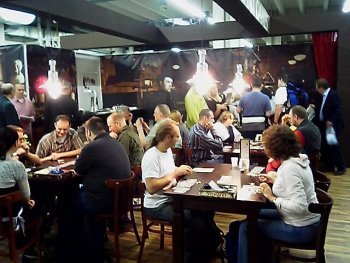 With all the booths being rather crowded at midday, I met with three friends from different parts of Germany for the lunch time. I had promised them that I would bring with some games which actually had not made it to the SPIEl but of which had rumours that they would be presented here. As you might imagine, embarking on several convention halls full of games can be treated as an adventure when you just come as a visitor who wants to absorb the unique atmosphere which can be felt only during the four days of the SPIEL convention. However, my angle on this is slightly different, since the fact that I want to keep at least a moderate degree of structuring within these daily reports forces me to make some advance planning for the convention days. Scheduling meetings with the major publishers is likewise important as planning which games I definately "need" to have a look at, so that I rummage through a few websites on the days before the convention in order to get an overview which games can be expected. Doing my anual preparation for the SPIEL 2007, I stumbled over the website of the relatively new American publisher SLUGFEST GAMES. Having some first look at their small but attractive looking choice of games, I quickly scribbled a note to visit their booth at Essen and sent an email to them asking a few details. However, sadly enough I had to find out that SLUGFEST GAMES would not be making the way over the Atlantic, but at the same instance I was delighted by their offer to playtest a couple of their games. With the games having arrived in time for the SPIEL, I told my visiting friends of their arrival, and they asked me to bring the games along for a round of testing. 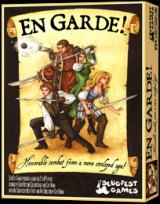 A cardgame about a fencing match for two to six players with an expected playing duration of about 30 minutes - I must confess that I was rather curious on how such a game would be organised and how the adventurous spirit of a fencing duel which is so well known from many movies could be brought within the limited scope of a deck of 85-cards! Unpacking the small gamebox and handing each player a playing mat and a token used to record his 'Poise' (Endurance or Focus), the game also reveals a deck of fencing cards which have beautifully illustrated with black and white illustrations which have been given an antique-looking, yellowing background colour. For starting preparations, the deck of cards is mixed and a hand of 7 cards is dealt to each player, while each player puts his Poise marker at a starting value of 10. 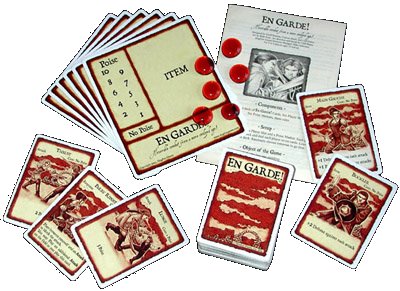 During his turn, each player first may discard any cards he doesn't want to keep before he re-fills his hand to the maximum of 7 cards. Then the player may use any Poise-Restauration cards and Item cards which he might have at his hand, before he progresses to the central element of his turn, a passage of arms with another player. This so-called 'Exchange' is initiated by the active player chosing an opponent and playing an Attack-card (like a 'Slash' or a 'Lunge' or 'Thrust') by placing it openly on the table. If in possession of a fitting card and desiring to use it, the attacked player may react by playing a Defensive-card like 'Parry', placing it opposite to the Attack-card and thus blocking the attack initiated by the active player. This simple pair of an attack and a defense would end the Exchange and with it the player's turn, but you can imagine that the game would be rather boring if the structure of a passage of arms would be so well arranged. Quite the opposite, different kinds of special cards add spice to the fencing, and allow the development of quite spectacular Exchanges which may rage between the players. On the one hand, an Attack-card may be bolstered with Attack-Enhancement-cards, an assortment of cards which usually gives more power to the attack by increasing its possible damage or restricting a defensive move. The defensive player on the other hand may be in possession of Defensive-cards like 'Parry Riposte' which not only can be placed to cancel the damage of the attack but which also allows the defensive player to play an attack card on his own which the attacker now must try to defend against. If a successful defense is made, the attacker once again may chose to react by playing a 'Press Attack' card, giving even more thrust to his initial blow and cancelling the defense made. However, if he should still be in possession of a fitting card, the defender once again may try to make a move against the new unblocked Attack-card. However, what would a real fencing match be without some amazing, unexpected twists, and here the Fancy Moves cards allow the players some special actions which otherwise would be impossible. Fancy Move manoeuvres range from 'Taste my Blade!' which allows the playing of an additional attack-card, to a 'Defensive Stance' which gives an extra reduction of damage or a 'Superior Technique' which can be used to totally negate an attack or to counter a Fancy Move played by the other player. The Exchange comes to its end when either Attacker or Defender cannot or does not want to play an additional card. This may be as early as after the first Attack-card, but it may also be after several cards have been played by both players. At this point the players will have to look at the cards played during the Exchange, and any Attack-cards which could not be blocked will cause an amount of damage which the opponent must substract from his Poise. These effects may be lessened or strengthened by items in possession of each of the players, so that a 'Second Sword' may cause additional damage while a 'Buckler' may be used to deflect blows and reduce damage. Also, Poise might be lost directly during an Exchange, since some of the cards represent difficult moves for the use which a player must pay with some Poise. If a player's Poise is reduced below "1", his marker stops at "No Poise", leaving him enraged and on the brink of defeat. This player now may use any cards he desires without having to care about Poise-costs, but his position is dangerous since the next hit which he cannot parry will lead to his ultimate defeat and his removal from the game. And, as might be guessed, the winner is the player who is still standing after all other participants have been defeated. Giving the players a turn or two to understand the basic playing principles, the game fastly picks up speed and develops into a furious battle with each player clinging to his rapier (or hand of cards). To my mind, both the speed and the atmosphere of fencing are captured surprising well by the easily manageable rules and the clearly structured cards, so that the players are drawn into a contest which is as enjoyable as it is dangerous. The player interaction is at maximum not only because of attack and defense movements but also because of unsuspected Fancy Moves, the use of a special item or attacks which may lead to the disarming of a player and thus the loss of an item he might hold. To my mind, the game is best played with up to four players, since otherwise the number of players makes it difficult for a player to survive a whole round if the other players might have an idea that he had run out of defensive cards. With up to 4 players, the hand of 7 cards still is large enough to carry through an attack and then possibly get over any attacks the other players might make during their turns, so that the aspect of the other players "teaming up" on a weaker player is not too high as to force the players to collect only defensive cards. This balance topples with 5 or 6 players, and it may cause early, unsatisfied deafeats if the other players are not as honorable as not to go all and attack the same player. Talking about honour, it is especially the Poise-Restauration cards which give some humorous glimpse on the "civilized" aspect of a fencing match, since the re-gaining of Poise usually is coupled with events like the wiping of a player's brow, the honourable permission of the retrieval of a lost sword or the interruption for a couple of refreshments. En Garde! comes with all the typical aspects with can be expected when a player's options depend on drawing cards from a random deck, but I still could discover during playtesting that there is some degree of strategy and speculation included which makes the game rather worthwhile. So, the players constantly have to evaluate their deck of cards whether it would be useful to cling to a reserve item to a good item which might possibly get lost, or whether it would be better to discard certain cards in search of more attack or defensive cards. The situation gets tense once a players Poise sinks dangerously low. A player on the brink of defeat will have to decide whether he takes a defensive stance, barely surviving round by round, or whether he puts all into one attack in the hope of getting an opponents Poise down to his own level. What is even better, the playing fun increases the more communicative the players are, and if played with a couple of people who like to add a bit of role-playing the whole fencing match really become a 'live' experience. A great little game!!! The other game we wanted to play begins just after the end of a long day in the dungeon with seven slayed Sorcerers and a great heap of golden guineas. All was really hard work, and now the worthy group of adventurers is heading for a well-earned rest at the famous "Red Dragon Inn"... Actually, I feel quite similar after a long day at the SPIEL convention, and I would also wish to be lying in my bed, but on the other hand it's not to bad to sit here, torture my keyboard and give you some more impressions of the day 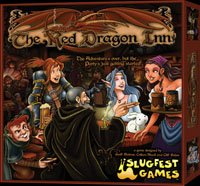 But now, let us have a closer look at The Red Dragon Inn, another cardgame by SLUGFEST GAMES which I simply had to introduce to you despite the fact that the publisher is not present here at Essen. In this game, up to four players take the roles of fantasy characters: Fiona the Swordmaiden, Deirdre the Priestess, Gerki the Halfling-Thief and Zot the Wizard. Each of the players is equipped with his own Character Deck of about 40 playing cards, with each of the cards showing his character and describing an action which may be performed while the players have a "chill-out party" at the Inn to celebrate their feats in the dungeon. Overall, each player starts the game with a purse of 10 Gold, and a player mat on which he can mark his current Fortitude (starting at "20") and his current Alcohol Level (starting at "0"). Also, a Drink Deck (containing different kinds of drinks and some events) is shuffled and one card from this deck is placed face down on the "Drink me!" space of each player's character sheet. Finally, each player is dealt a starting hand of seven cards which were drawn from his own Character deck. The winner of the game will be the player who has the last remaining character in the game, meaning the his character neither has run out of Gold nor that his Fortitude marker has dropped below his current Alcohol Level. A party indeed! During his turn, a player first has the option to discard any cards he might not want at the moment before he is allowed to re-fill his hand to a maximum of seven cards from his Character deck. Looking at his hand of cards, the player then may play one of his cards and perform the action described on his card. Afterwards, he draws one card from the Drink deck which he places on an other player's "Drink me!"-pile without looking at the card. Finally, the player ends his turn by revealing the top card of his own "Drink me!" pile and acting on the instructions on the card. As you can see, the central part of a player's turn is the use of one card from his hand, and these cards can have some quite different effects on the game. Thus, some cards cause a minor brawl between the player's character and another character, causing the other character to loose some Fortitude. Other cards have influence on the Alcohol Level or the dealing out of cards from the Drink deck, while even other cards mean the loss of Gold or perhaps the start of a gambling round. Usually, the player's action ends with the playing of one card, but when the circumstances are right other players may be in possession of response-cards which might turn the intended damage back onto the original player or which might remove their character before the damage is inflicted. However, there is also the start of a gambling round, which causes a little interlude to the normal course of the game. For a gambling round, each player has to ante a coin to the pot, and then in turn each player can play a card which might put him into the position of the current winner of the round. At the beginning, the initiator of the gambling round is in the winning position, but as the other players play either fitting "Gambling" or "Cheating" cards the position of the current winner changes around the table. When no player can (or wants to) play a gambling card any more, the round of gambling ends and the pot may be claimed by the last player in the position of the current winner. Afterwards, the game resumes with the player who had initiated the gambling round being allowed to deal out a card from the Drink deck and then turning over the top card of his own "Drink me!" pile. In most cases, the Drink cards show various kinds of brews, usually causing an increase of the player's Alcohol level by 1 to 4 steps. However, there are also cards included like "Coffee" which have a sobering effect and thus lower the Alcohol level or unswallowable "Troll Brew" which leads to a loss of Fortitude. Also available are "Chaser" cards, forcing the player to gulp down just another card from his "Drink me!" pile as a chaser to his current drink. Finally, some special Drink-events like a "Drinking contest" are included in the drink as well, and these cards may lead to another small interlude which causes the players to ante Gold and draw Drink cards. As said, the last conscious player in possession of some Gold is the winner of the game, and although my short description given above may not sound too spectacular I consider this game to be an absolute MUST HAVE! If played with a round of four talkative players with a weak spot for role-play, the basic setting with four different fantasy characters drinking their way deep into the night offers a marvellous starting position for a great, fast-paced gaming experience. 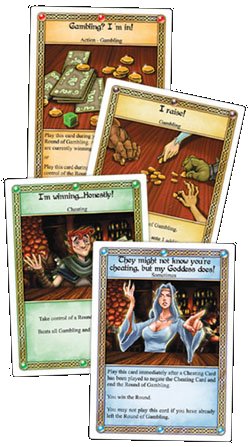 First off, the Character deck of each player is beautifully illustrated with images showing his character in different poses, and even better is the fact that the actions available to each character have been developed in regard to his unique characteristics. Thus, Fiona the Swordmaiden can stand a good load of drinking and nicely deals out damage, while Gerki the Halfling-Thief has nice options for cheating in gambling rounds and hiding in the shadows when the situation gets dangerous. Deirdre the Priestess on the other hand has nice Healing Powers (making up for her poor alcoholic constitution), while Zot the Wizard makes spectacular moves whenever he looses control over Pooky, his Rabbit familiar. The fact that each player possesses numerous cards which allows him to react to different challenges during the game leads to many hillarious situations in which a fantasy inclined group of players is howling with laughter, and the although the duration of a round of playing with only 15 to 30 minutes makes the game a nice entree before a heavy strategy game, the addiction factor is so high that 30 minutes quickly become an hour or two. Be aware: like Ca$h'n Guns from REPOS PRODUCTION this game is probably not suitable for gloomy strategist gamers who prefer a peaceful atmosphere of silence when plotting out their next 36 moves, but the game cannot be recommended highly enough for any gaming group who loves easy going, highly entertaining and interactive cardgames. Just the right game after a long day in the dungeon! 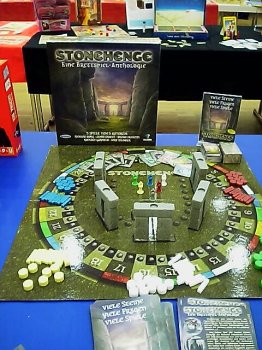 Splitting up with my friends after lunch in the "Red Dragon", I went to have a look at a rather unusual project of the SPIELZEIT VERLAG. Creating a set of playing materials which is centered around the ancient site of Stonehenge, the well-know boardgame authors Richard Borg, Mike Selinker, James Ernest, Bruno Faidutti and Richard Garfield have taken up the challenge to create different games suing the same material. In the end, this has lead to the publication of the first Boardgame-Anthology, containing different games like a duel of King Arthur's Knights, a meeting of High Priests or even an Alien Chariot-Race. The rules of each included variant game are well-tested and fine tuned, but somehow most of these variants left me somewhat uninvolved. Due to the fact that the same playing material is used in each of the games, I could not really identify with roles like a Knight, a Priest or an Alien. Of course, it was just the idea that all authors had to use the same pieces, but after some playtesting I came to the conclusion that I like a game not only for its rules but also for its uniqueness. An this multi-purpose playing material somehow did not carry such a feeling of uniqueness. 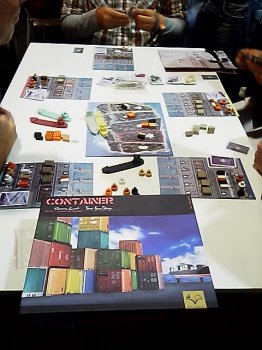 For the final test for today, I went to play Container by Franz-Benno Delonge and Thomas Ewert. It caused me a heartache to see the game since Franz-Benno Delonge had died this summer at an age of 50, and now one of his last games has arrived to show that he still had been busy creating new games to the last. In Container, each player takes up the roles of producers and ship-owners, and starting with a cargo ship and a small piece of land in a harbour base the players set out to get rich by producing goods and shipping them to distant shores. Each player can have up to four production plants for different kinds (colours) of goods in his harbour, but a player is not allowed to load these goods onto his own ship to sell them elsewhere. Instead, he will have to offer the goods to the other players at low prices, and they will come with (virtual) trucks, pick the goods up and bring them to their own harbours where they may put the goods on their wharfs for sale. This mechanism ensures a constant circulation of the goods in the game, and it also prevents that a player would transport his own goods which would be - as you will see - contra-productive to the game's aims. If a player has placed goods on his own wharf, he may sell them at increased prices to the other players, and if an agreement is reached the buyer will have to come with his freighter to pick up the goods and to carry them to distant countries. The price the seller can demand for a kind of goods strongly depends on the availability of these goods in the game, and so it may vary from low to high when the supply is getting short. However, a player may not amass a an endless amount of goods, but he has to purchase warehouses to store a minimum amount of goods. As indicated, a ship loaded with goods may take course to distant countries, represented by an island at the middle of the table. At these distant shores each player once again maintains a trade representation, and so the arriving player will have to offer the cargo in an auction to the other player. However, once the highest bidder has been found, the seller actually may decide whether he sells the goods to the highest bidder (with the amount of the bid being doubled by the state as a subsidy), or whether he wants to purchase the good himself, paying for them the amount of money the high bidder has offered. Anyhow, the player who finally has acquired the goods placed them within his trade representation on the island. When the game comes to its end, the players have to reveal their secret value cards which were distributed at the beginning of the game. Each player now has different values for the different kinds of goods available in the game, and for these prices the players may cash in their goods which they have accumulated at their trade representation. However, a part of the goods has rotten away, so that the players will not be allowed to cash in the type of goods of which the have most. After cashing in the goods, the player with most cash will have won the game. Container is a tactical economy and trading game, without any element of luck but instead with a lot of player interaction when it comes to the buying and selling of goods. Apart from the nicely designed cargo ships the playing material is a bit functional, but the topic of shipping and trading to my mind is implemented quite well. The constant turnover of goods is ensured by the production and selling rules, and I am sure that Franz-Benno Delonge would be quite proud of seeing this nice strategy game being published. Turning towards the exits, the SPIEL once again proved that is not just a place where you can go and playtest games - sometimes a day at the convention can be surprising the unsuspecting visitor with an event which could not have been expected. Taking a shortcut I went past the "Inventor's Alley" where new, unknown authors are allowed to present their prototypes, I there actually met a colleague from my department who was presenting his prototype here at the SPIEL. 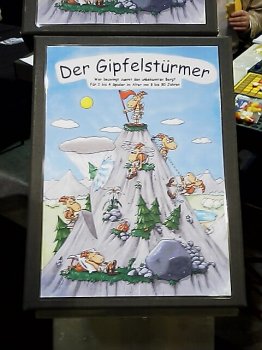 Knowing each other only fleetingly from daily work, both of us did not know of each other's interests in gaming, and so I was rather surprised to find that a colleague of mine actually had a liking for designing games. Taking a seat to have a look his prototype of "Der Gipfelstürmer", it was already the cute-looking artwork of Mountaineer-Goats which made me go for a testing round of the game. Basically, it is a game for up to four players which can be subdivided into two phases. In he first phase, the players take mountain pieces to build up a mountain on the gameboard, following certain rules in terms of the placement of the mountain pieces so that the starting corner of each player could not be totally cut off by high cliffs. After finishing the mountain, each player takes three mountaineers on the trip to the highest space, staring in a corner and rolling a special dice to move the figures. Special actions become available by action cards, and in the end the first player with his three mountaineers reaching the top space will have won the game. 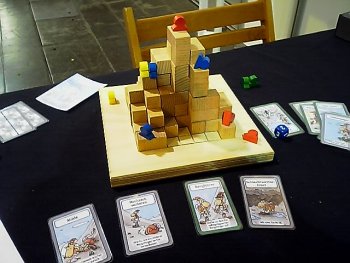 The game still needs to get a bit of fine tuning, but as I was told there were a lot of additional rules which still were in the testing phase. So, there could be a possibility to add bridges or hazards like a Yeti, and I will certainly keep an eye on the further development of this idea. And with this recount of a rather unexpected turn of events, I will turn the computer off for today ! See you tomorrow for the final day! Sunday, 21st of OctoberWow, time was really flying this year! We have already reached the final day of this year's SPIEL, and I cannot believe that I am actually writing the last report for this yea. However, I have saved my tests of some very interesting games for this last day, so I think that you will not be disappointed… It has been years since Karl-Heinz Schmiel published the game Die Macher which was focused on elections in modern-day Germany. However, this year he finally once again has approached a topic of political importance, although we have to go back in time for quite a few centuries to come to the era of ancient Rome. 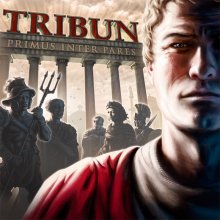 In Tribun, each of the players represents a rich family of Patricians in Rome, and each of the families tries to get more powerful by gathering influence among the different factions of Rome and by possibly installing one of their family members as a Tribune, being something like an intercessor for the lower classes with high esteem and political powers. To win the game, each of the players would need to fulfil a number of victory conditions, and at the beginning of the game each of the players receives and identical overview sheet listing the possible victory conditions and how many of them need to be fulfilled in the current game. However, already the choice of the victory conditions for the game reveals a typical Schmiel-idea, since there exist different kinds of overview sheets bearing small hourglasses, thus representing the approximate time the players would need when this set of victory conditions would be chosen for the current game. Once the players have agreed on the victory conditions, they receive an overview sheet for their family which lists the playing options available in the game and which also serves as a placement mat for the playing material the players will acquire. The players receive some starting money and also, depending on the number of players participating, a number of playing figures (which might be characterized family members or servants). Finally, a deck of faction cards is shuffled from which each player is dealt six cards of which he may keep four. The other cards are shuffled back into the deck. The deck of action cards contains cards of the seven different factions leaving in Rome and influencing the political life, and in a rising order of importance these factions are the Gladiators, the Legats, the Pretorians, the Plebeians, the Patricians, the Priestesses of Vesta and the Senators. The cards of each faction bear a different colour and also different values, and furthermore for each faction exists one card of a special character which is also included in the deck. 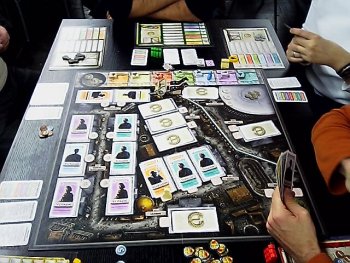 A round of play starts with new cards from the faction deck being placed at the different locations on the gameboard if there are empty spaces available. The card placement rules for each of the eight available locations are quite different, so that revealed cards are placed at the Thermae, the Forum and the Curia, while hidden cards are placed at the Latrine, the Auction place, the Catacombs and the Temple of Vesta. However, at each of the three spaces available at the Curia cards are placed until they reach a total value of "5" or more, and at the Catacombs a small stack with a total of five cards is placed. During the following placement round, the players now in turn are allowed to send their figures to bidding spaces adjacent to the card-slots of the different locations, and the occupation of a bidding space will possibly enable a player to the take card(s) on offer there. However, only one figure may occupy a bidding space, so that the players have less and less choice as to where to place their last figures. Also available for figure placement are the two bidding spaces available for each faction which will allow up to two players to try to gain control of this faction, and finally there is a possibility to place figures at the Victory Column where it is possible to gain Laurel-Markers or the Money-space where the players will gain some money for each figure placed there. However, before the figures at the faction spaces are evaluated, the players first have to deal with the figures on the bidding spaces of the locations:
After dealing with the locations, all figures are removed from the locations and the round continues with the evaluation of the factions. A player who has placed a figure at a bidding space of a faction now must play at least two cards matching the faction colour to gain control over an uncontrolled faction. However, the cards are not discarded but placed openly in front of a player. A player who has taken control of a faction will receive a Faction Marker if he should not already possess a marker of this faction. However, the issue gets more difficult if another player already is in control of the faction, since now the player with a figure on the bidding space only may take over control of the faction if he succeeds in either playing more valuable cards of the faction or a greater number of faction cards than the current controller of the faction. Thus, it gets harder to take a controlled faction over, and if a sending player should have decided to place a figure at a bidding space for the faction as well, this player now needs to look whether he still has enough cards to take the faction over since he now has to make a better bid than the first player. In the end, only one player can get in charge of a faction, so that the withdrawing player may retain all his cards but one (which is discarded). The gaining control of a faction gives a player access to different tokens he has to collect if he wants to fulfil the victory conditions. So, they may receive Sesterces, Laurel markers, Legions or a Scroll of Recommendation. However, the control of a faction not only means the gaining of these one-time benefits, but a player who remains in control of the faction also will receive some kind of benefit each round while he stays in control of the faction. These benefits once again may be similar to the benefits listed above, but they might also be the possibility to exchange the Scroll of Recommendation for a Tribune-marker or other special powers like the possibility to assassinate cards other players have used to gain control of a faction. Also important are the character cards available for each faction, and although these cards have a value of zero when making a bid for control of the faction the player using such a character will gain an additional benefit for taking the group over. Here one specific element of tactics also should be mentioned: a player only may play cards of a faction when making a bid for controlling the group. It is not possible to add additional cards to these group at a later time during the game! The acquiring of a Tribune-marker also means the fulfilling of a victory condition. Apart from certain sums of Sesterces, Laurels and Legions other victory conditions are the possession of a "Grace of the Gods" marker or of a number of Faction Markers, and if a player should succeed a certain number of victory conditions (as listed on the overview sheet chosen fore the game), that player will be declared to be the winner. However, to prevent other players from gaining the necessary benefits and to protect a faction from being taken over, a Chariot figure is auctioned between the players at the end of the round, and the owner of the Chariot may place it onto one of his factions for the following turn, preventing any other players from making a bid for that faction for the duration of the turn. Actually, this short descriptions should summarize the body of the rules quite accurately, since only a few more twists are included which serve to solve any unclear which might arise. As you see, Tribun is a game in which the players need to collect different kinds of tokens in order to fulfil the victory conditions and become the winner, but to my mind few other authors exist which are able to fine-tune such mechanics like Karl-Heinz Schmiel. The different elements in the game work together like a clockwork made in Switzerland, and I found it especially worthwhile that, although a player might get into a leading position with control over a few important factions, the gameplay is flexible enough to prevent a player from fortifying his position. A timely assassination may be all that is needed to get another player into a position for successfully taking over a group, so that the players are required to re-adjust their strategies during the game more than once. However, there definitely is a palpable element of strategic planning in the game, since the making of a successful faction take-over usually takes a few turns of collecting the right cards. And, if you remember my review of Utopia and the random drawing of cards in that game, Karl-Heinz Schmiel cleverly reduces such an influence by his clever card distribution system which uses the different locations on the gameboard. The game actually won the audience ballot which the magazine "Fairplay" conducts during the days of the SPIEL convention, and I think that it did so quite deservingly. Apart from the playing mechanism which is complex but still not overburdened, the game offers possibilities for variation like the different victory conditions and a points-based ranking system, and this is coupled with a unique, dark but interesting artwork which makes the game a rather mature product which is developed close to perfection in every aspect. Do you remember my pre-views of "Chang Cheng" and "Medievalia" which I did before the convention started? Today I went to see both publishers in order to find out how the convention went for them. 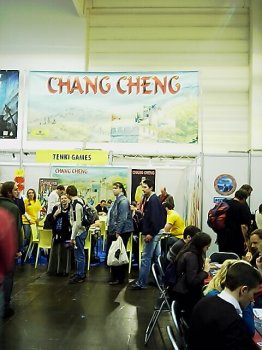 In case of Chang Cheng I found the weel sized booth of the publisher TENKIGAMES in Hall 12, a Hall directly at the main entrance where mostly bigger companies like KOSMOS, DAYS OF WONDER and HASBRO maintain their booths. TENKIGAMES was lucky since another publisher had emptied this booth before the convention, and so they were at a very good spot to present their games. This actually found its consequences in the sales numbers of Chang Cheng, since the game was SOLD OUT today! 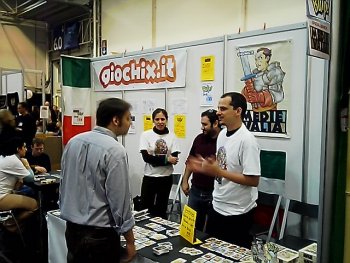 The positioning of GIOCHIX, another Italing company was quite different. Being a rather small publisher they had booked a both in Hall 4, a place where only small publishers and the used games market can be found. However, as it looks they might have found distributors here at the convention for their rather nice resource management and medieval combat game Medievalia, and couple with a good porting of visitors they did not seem unsatiesfied with the convention either. 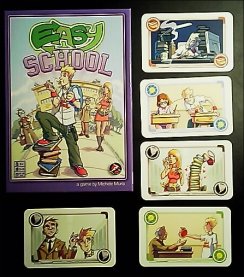 Talking about small Italian publishers, let's also have a quick look at Hall 6 where Michele Mura and the team from RED GLOVE were presenting the cardgame Easy School. In this game, they players need to navigate their way through two semesters at school, finding different imaginative solutions to survive the exams and trying to avoid trouble with teachers or when trying to date the most-wanted Beauty of the School. During the game, the players collect Exam cards of five different colours, with each type of cards showing a different way to cheat in the examinations. During his turn, a player may turn over cards from the random deck one by one, placing each Exam card in front of himself and thus building his own display. However, if he comes upon a Trouble card, he has to discard a card from his display, and if he continues and finds another Trouble card in the same turn he has to discard two additional cards and his turn ends. Instead of taking cards, a player also may decide to have an examination, provided he has at least three different kinds of Exam cards in his display and no Trouble card. He then has to turn around the topmost card of the drawing pile, and if he does not find a Trouble card the examination is passed and the three Exam cards will be moved to the player's victory pile. If the player should possess four different Exam cards, he has done well and does not need to turn over a Trouble card, and if he should possess even all five different types of Exam card he may place all five cards into his victory pile plus an additional card as a bonus for his extraordinary examination grade. Sharing his knowledge with the other players, all others now may move one of the cards from their display to their victory piles as well, provided its is a card of a colour matching one of the cards used by the active player. Trouble cards may be lost by taking a pause and handing up to one card to each other player. The other players do not place the cards into their displays, but instead they have to discard one card from their display, or, if the display is empty, the topmost card from the victory pile. Two cards "End of Term" were included in the drawing pile, and every time such a card appears during play the players will be allowed to take one more examination before victory points are awarded. The players now count how many cards of each colour they have in their discard pile, and the more cards of a type they have the more victory points they will get. The game ends after the second term and the player with most victory points will have won. Seeing the game presented on a table, my attention first was drawn to it because of the rather nice artwork which is not too usual for a small publisher. Sitting down curiously and starting to play, I discovered that the game bases on the same playing principles as Coloretto by ABACUSSPIELE. However, I really liked the school topic of the game and I think that is has been chosen rather fittingly spice up this nice variant game. Considering a price of seven Euros, I certainly took a copy of this small find home with me. 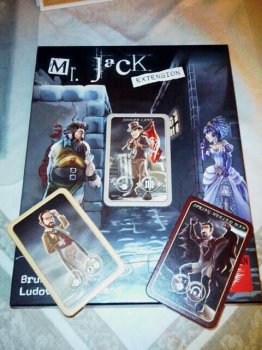 A game which I liked quite a lot at the SPIEL last year was the dark Mystery game Mr. Jack by HURRICAN GAMES. As it seems, my likingfor the game was not unique and a good del of people seem to have fallen for this nice crime solving game which also just has won the International Gamers Awards 2007, so that HURRICAN GAMES now decided to incorporate five new characters in the game to offer the players some variation. The basic rules of play are only changed slightly to to use the variant characters included in the expansion. Thus, the number of characters which may be included in a round of play still remains to be eight, but now only the four characters of Sherlock Holmes, Inspector Lestrade, Jeremy Bert and John Smith had become fixed characters because of their rather important abilities. The players then are dealt other nine characters (the Jack player receiving five cards), and each player choses two characters which he wants to add to the game. Showing the chosen characterst to each other player, the players now go for setting up the gameboard. Mixing the cards of the characters chosen for the rounds, the players take turns to draw character cards and place their playing pieces on the gameboard. Thus, no fixed positioning of the playing pieces has been pre-defined, but instead the gameboard is set up for new each time the players start a new game. Thus, quite a lot of strategic options become available right from beginning, with the players trying to position the characters they draw at strategic spaces. However, in order to prevent the Jack-player to gain too much of an advantage, Jack may not flee in his first round. The rules for the new characters are as easy as the one for the characters of the basic game:
Being sold at the SPIEL convention for 15 Euros, I heard that people were complaining a bit that this expansion only includes the five additional characters. However, leaving the question of the pricing aside, I found the inclusion of these new optional characters rather enjoyable. Their special abilities offer new strategic options which will prove quite challenging even for seasoned Mr. Jack players, and furthermore the new characters also fit quite perfectly into the game in terms of playing atmosphere. One thing I still need to make my mind up is whether I really like the fact that now the characters can be placed freely on the gameboard. There are a lot of choices to be made, and considering the fact that four characters remain fixed in each game I wonder whether in not would have been more efficient to leave these characters at their original starting places and to shuffle and deal the other characters to the other starting designated in the basic game. This procedure should save time and I don't think it will throw the additional characters out of balance. 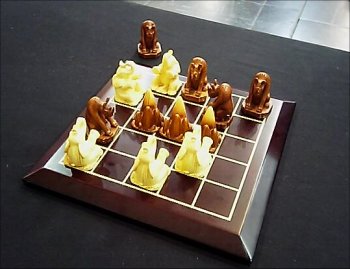 On the neighbouring booth I found the abstract but beautiful looking game Siam by the French publisher FERTI. Scoring high in the French gaming awards at Cannes, I had a testing round of the game, and although I am usually not a big player of pure strategic games, I found Siam rather challenging and entertaining. At the beginning of the game, three playing pieces resembling mountains are placed at the middle of the gameboard, and taking turns the players either place their own playing pieces at one of the outer edges of the board or move one of their playing pieces on the board. One of the players uses Rhinos, whereas the other player uses Elephants, and it is the aim of the players to succeed to be the first one who pushes one of the Mountains off the board. The facing of the figures on the board is very important, since a figure only may push if it faces forwards. A player may move one figure for one step during his turn, and he may also change the facing of this figure. Other figures may be pushed by the moving figure, as long as there is no figure within the row of pushed figures which faces the direction opposing the pushing player. In this case, no pushing may be made, unless the pushing player has more of his playing pieces in the same pushing row which push into the same direction. Thus, a player may perform a pushing action if the pushing playing pieces outnumber the opposing ones. Moving to and fro on the gameboard, the players try to build up a strategy to defeat their opponents. The game plays rather fast, but the more it is played the more challenging it gets when the players go for more complex movements and discover the variety offered. I played the game three times in a row and the duration grew a bit with each round, but I think that Siam is a rather good example of a modern purist strategy game. Coming with beautifully designed playing pieces and gameboard, the game comes up to the high production quality which usually only is offered by the expensive editions of the German publisher LUDO ART. 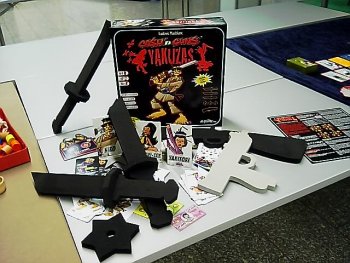 Deciding to go for something less brainteasing, I went to the booth of REPOS PRODUCTION where Cedrick Caumont and Thomas Provoost were presenting the new expansion for their 2005 smash-hit Ca$h'n Gun$. The new Yakuzas set does not only introduce three members from the Japanese Mafia to the game (thus enlarging the scope of the game to up to 9 players), but it also includes new rules for team play which are required if players want to use the Yakuza-characters. Ca$h'n Gun$is a game in which up to 6 Gangsters have a dispute about dividing the booty of their last crime. During 8 rounds of play, each player first chooses one of his handcards (consisting of 5 bluff cards, 2 shooting cards ("Bang") and one rapid-fire card ("Bang! Bang! Bang!"). After chosing a card, the players simultaneously point their guns at players of their choice. These players not have to decide instantly whether to back out from the round or keep standing. All players who have remained standing now reveal their cards. Any character who has been hit by a shooting card gets a wound and drops out of the round as well, whereas all players still standing after dealing with the cards divide the stash of booty of the current round. After 8 rounds, the player with most money has won, but a player who has taken three wounds during the course of the game has been killed. A rather funny, interactive party-style game. Now turning to the Yakuza-Expansion, the Yakuza-characters differ from the standard Gangsters by the fact that the are not equipped with Guns but with Tantos (Swords). Each Yakuza has two "Tanto"-cards which he can use just like the Gangsters use thei "Bang!"-cards, but - having no ranged weapons - the Yakuzas can use their Tantos only on neighbouring characters to their left and right, thus requiring the players to sit in a specific order around the table. Also, the limited range of these hand weapons illustrates the reason why the Yakuzas need rules for team play, since otherwise a single Yakuza character would be in a distinct disadvantage in comparison with the other players. However, a bit of a surprise element comes with the use of the Tanto, since it swishes over the head(s) of any player who might have backed out of the round and it hits the next player which is still standing - even if it should be another Yakuza! Still, the Tanto is not the only weapon a Yakuza possesses. Thus, each Yakuza also is in possession of one Shuriken (throwing star), and during the course of the game the Shuriken may be used to make one ranged attack just after the fast-firing "Bang! Bang! Bang!"-cards but before and normal "Bang!" might be dealt with. An additional advantage is the fact that the Shuriken may be thrown at a character of the Yakuza's choice - it does not need to be the player at which the Yakuza pointed during the phase when the victims were chosen. However, the rules demand from a Yakuza player a certain degree of skill, since the rubber foam shuriken actually needs to be thrown (!) at another player's character figure from a certain distance. Sounding a bit silly on first thought, the impact of the Shuriken and its possibility to chose a victim during the phase when the cards of the players are revealed would be too unbalanced if the Shuriken would count for a direct hit. As indicated, the rules also include necessary provisions for team play. Thus, the players now play in teams of two or three Gangsters or Yakuzas, and at the beginning of the game and after the first half of the game the members of each gang are allowed a short phase in which they can work out their strategy. This strengthens interaction, especially due to the fact that players usually will try to agree on secret signs by which they can give hints to their other gang members. Also, the expansion also includes new Super-Powers (or Super-Kiai) cards for the Yakuzas, so that they may have surprising talents just like the Gangsters have in the basic game. And finally, a deck of item cards is included, each of which makes the game more unpredictable and even deadlier. As you might see, the Yakuza-Expansion fully takes up the hilarious spirit created by the basic game, and to my mind it drives the interactive aspect even further due to small twists like the throwing of the Shuriken or special powers which force the players to change seats. The fact that the Yakuza players have to follow slightly different rules than the other Gangsters integrates well into the game, and small specialities like the loss of Honour when backing out of a round quickly encourage the players to spice up the game with a little bit of role-play. The only element which goes perhaps a bit too far are the item cards since they have a quite destructive impact on the strategic element which is left in the game, but to be honest I did not mind this at all but laughed even more when a player didn't expect an item to spoil his plans. To my mind, this expansion really is a worthy, must-have for all owners of Ca$h'n Gun$. And I shouldn't forget to mention that anybody who bought a copy of this expansion here at Essen got a new silver Uzi-Machinegun as a free add-on. That's something which will shock your opponents!!! 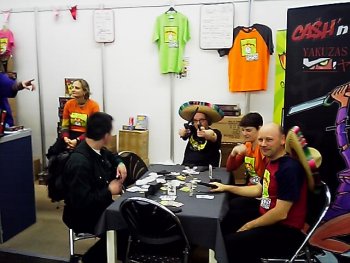 Actually, it was also some good news to hear that the 500 copies REPOS PRODUCTION brought with them to Essen sold out today, so Ca$h'n Gun$ certainly still has its fans. There also exists a Live-variant of the game which can be played with larger groups of people (no guns included, people use their fingers), and this also met quite a few interested people at the demonstration rounds during the convention. Finally, Thomas also told me that they were already thinking about another expansion, being focused on B-movies and having to do something with Vampires. Just like in the movie "From Dust till Dawn"! 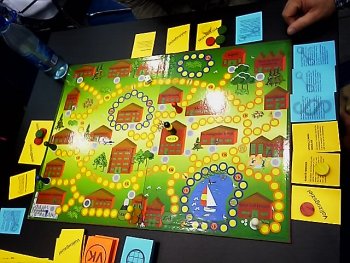 On my way to the final playtesting for the afternoon, I once again found a rather obscure booths for which the SPIEL is known as well. Thus, I came across a booth operated by the State Penitentiaries of the cities of Moers and Geldern, and on this booth they were presenting a game which had been designed by the prisoners as part of their social work programme.  The game Ohne Bewährung (that means: "no release on parole") is a dice-rolling game with some light strategic possibilities included, since the players have to visit certain spaces while serving their sentence in the penitentiary. Representing different aims for the resocialisation of prisoners, the players also are taught quite a bit about life in prison by short illustrating texts, and I was told that the game did receive quite a bit of attendance by the German press. And these is also a rather nice story concerning the release of the game: The penitentiary does not have the bduget to buy high end computers for their prisoners to work on, and just when the game was finished a crash of a harddrive caused the whole gameboard to be lost. The prisoner who had made the board was scheduled to be released two days after this happened, but when he found out about the board he volunteered to stay longer and once again fisnihed the whole design. Well, this whole matter certainly illustrates a angle on boardgames I have not yet seen before. While examining the game, it became clear that a lot of work and ideas had been added as to present the situation of a prisoner in modern days, and to know that each game is handmade within a prison certainly gives the whole matter a quite interesting view. 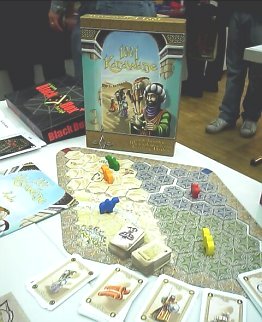 To my mind, a very interesting account of a caravan travelling through endless deserts has been made by ARGENTUM. In 1001 Karawane, the players set up a modular gameboard which contains one fixed region with the trade base of all participation players and three different desert regions in which face down desert tiles have been spread. It is the aim of the players to collect three magical artefacts (Flying Carpet, Magic Lamp, Amulet), each of which can be found in a different part of the desert. Alternatively, a player also may win by earning a certain amount of Gold by trading, thus enabling him to purchase the wanted artefacts . At the beginning of a voyage into the desert, each player may chose to equip his Caravan with a combination of Trading goods, Guards, Water. Of course, the loading capacity of a caravan is limited, and so the players only may chose six of the mentioned people and resources to carry with them. Then the players set of for a voyage into the unknown, travelling three spaces per turn and approaching the face down parts of the gameboard. During his travel in the desert, a player may look at the desert tiles he crosses, and he might stumble upon useful places like an Oasis so that he can save his water during this turn or a Caravan-post where so that guards can be saved. Otherwise, a Caravan uses up one unit of water by the end of the turn, and at the beginning of a turn a card showing either one, two or none Raiders had revealed which now may force the player to show that he has more Guards than there are Raiders or to discard one Guard card. Likewise, the players may encounter Cities where they can exchange their Trade Goods for Gold, and in each section of the desert there will be one City, one Oasis and one Caravan-post which can be discovered. In addition, each of the three sections also houses a special place, and at these places the players may find the magical artefacts which are needed to win the game. However, one of the decisive elements of the rules is that the players do not reveal the desert tiles they cross to the other players, and even if they make use of the special abilities of a space they will not have to reveal the space to show that they are allowed to do so. Thus, there is a possibility for cheating in the game, but this may actually be discovered if another player later wants to use a tile as well and also playing this way actually would spoil an otherwise quite clever idea. The point about not revealing tiles is that a player then has the option not to make use of the possibilities offered by the space, but instead may proceed as if nothing had happened. This may be done to foil the other players about the whereabouts of the different places which can be found in this section of the desert, since the quick purchase of an artefact would draw the other player's attention since they now would know where to get this artefact. Of strategic importance also are the four Map/Genie counters which each player receives at the beginning of the game. A Genie may be used to exchange two unrevealed tiles anywhere on the gameboard, and if a caravan should be in such a tile it would change its position together with the tile. A Map on the other hand can be used to reveal a tile, fixing it to it permanent position and preventing a Caravan to be misplaced. On the other hand, a revealed City is visited by many other merchants, so that trade at a revealed City is restricted to two Trading Goods per Caravan. The counters are double sided and may be used either as Genies or Maps, and especially during the endgame they prove to be rather valuable since they can be used to create quite a few different shortcuts and delays. Players who have successfully acquired the third artefact might find themselves in the backyard of the desert if they do not have a map to secure their current position, and there is a danger of such a Caravan running out of water and its owner being forced to discard all cards currently carried by the Caravan. The only possibility to get anything permanently is to return the Caravan to the starting town, where all returned Gold and artefacts will be stored by the player. I really liked this game due to the fact that the movement over facedown tiles and the allowance only for the active player to check out a tile's true nature make the game exciting and add a good degree suspense. On the one hand, players will have to memorize beneficial places they have found in the desert, and they also have to ask themselves whether they really should reveal a tile's position by interacting with it, or whether they should turn around to search for even other tiles in order to collect more knowledge. Memory, bluffing and a good deal of interaction through the special counters all are part of the game, and although the desert certainly is build up at random all players will have to search the desert on equal terms. Rounding up my good impression, the game includes some nice graphics and full English rules. 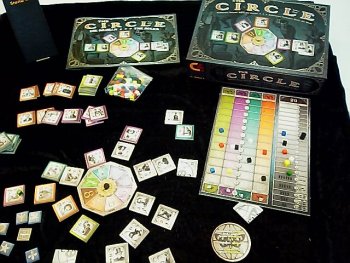 A dark looking game with a theme coming from the field of Espionage is The Circle which comes from the newly established publisher C4. Focusing on the end of the 19th Century, a sinister group called "The Circle" is making a bid for world domination, and the players take the roles of directors of the intelligence services of different nations which struggle to stop the Circle by use of their spies. The main instruments to keep order in the game are a scoreboard on which the players keep track of the four sections of their intelligence services and of the Victory Points, and also a Time Wheel which simulates the passing of time during the game. Money does not play a role in the game, since what a spy really wants is to uncover secrets. Thus, "Secrets" actually form some sort of a currence, and at the beginning of a turn each of the players receives secrets which he may assign to one or more of the sections of their intelligence service. The sections are "Intelligence gathering and analysis" (INT), "Strategic planning and support" (SUP), "Agent control and recruitment" (REC) and "Security and external operations" (OPS), and the current level of secrets available in each of the sections is recorded on the scoreboard by the players putting cubes of their colour within the tracks of each of the four sections. However, a player also may use two (or even all four) of his secrets to get new spies into the game. At the beginning, no player has a spy working for his intelligence service, but this will change in time when the players hire spies which be come available. There exist spies the colour of which defines them as belonging to the field of operation of one of the four service sections, but there also exist some spies with a grey border marking them as neutral spies. For each of the four service sections four different types of spies assist, and all these spies have been openly placed on the playing table before the game has started (thus forming a total of 16 small stacks of spies). The neutral spies on the other hand were shuffled before the game and put into a hidden pile, with only the first two of them being revealed to the players. As indicated, a player may use two of his start-of-turn secrets to get a new coloured spy into the game, and if the player uses the other two secrets as well he may also activate one of the grey neutral spies. Of great importance for the game is the fact that each of the spies in the game has an activation number which defines the number of turns the spy needs to get ready. When a new spy comes into the game, he is placed next to the Time Wheel, at the side of the wheel which corresponds to the activation number of the spy. At the end of his turn, the starting player will twist the Time Wheel one step clockwise, meaning the all spies aligned to the wheel get one step closer towards activation. If, after spinning the Time Wheel, one or more of the new spies have crossed the activation marker, the players will get an opportunity to hire the new spies. If it is a coloured spy, the players just look at the "secret"-indicators on the track of the service section corresponding to the spy's colour, and the player with the highest amount of secrets within this service section will receive the spy and may place him in front of himself. Grey spies - and also coloured spies in case of a tie between the players secret-rankings - will be auctioned, so the players will be allowed to bid secrets either from all of their service sections or just from the section of the matching colour in case of a coloured spy. Unlike the undisputed distribution of spies to a leading player, the auction requires the highest bidder to "pay" the secrets he has bet and reduce his marker(s) accordingly. So you now know how the players can recruit spies, but what is done with them? During a turn, before the Time Wheel is turned, the players can use as many of their spies as the wish. This is done quite similarly to the adding of new spies at the beginning of a turn, since a used spy need to be placed next to the Time Wheel, close to the side of the wheel matching his activation number. The player who has used the spy puts a coloured token on him to show that the spy belongs to his organisation, and he will receive the spy back if, after a few turns, the Time Wheel has be spun so far that the spy once again has crossed the activation marker. Then the player may take his spy back, and he is once again ready for action. Each spy has specialised on performing one of sixteen different types of actions available in the game, and whereas the actions of coloured spies broadly qualify as being close to the service section of the matching colour, the grey neutral spies may have an action which belongs to any of the four service sections. For example, service section INT has spies which may their boss to receive additional secrets or reduce the number of secrets of another player, section SUP spies may support spies to move forwards on the Time Wheel or delay other spies and section REC offers spies which help in recruitment issues by temporarily changing a spy's colour or forces an other player to fire a spy. However, the actions of section OPS seem to be of most importance, since they include the killing of an other spy, the exchange of spies between two players and the capture of a member of the Circle. An other possibility to capture Circle members is for a player to increase his secrets-indicator in one of the service sections over the value "12". In this case, the indicator drops back to "1" but the player scores two Victory Points for capturing two Circle-members. Each time a player uses a spy or secrets which allows him to capture members of the Circle, this player may advance his Victory Points marker on the scoreboard by one or two steps. However, it must be noted that the Circle also has a Victory Points marker on the scoreboard, and whenever one of its members is caught the Circle will increase its endeavors to reach world domination and will receive Victory Points as well! Thus, the game cannot be won just by capturing Circle members, since this way the Circle would have the needed 20 Victory Points faster than any of the players. Thus, the players also must use their spies to infiltrate the Circle, and once per turn a player may send one spy to infiltrate the Circle instead of using him for an action. The spy is turned over to represent his infiltration mission, and the player will score one to five victory points depending on the value of the spy. In this occasion, the Circle will not score any Victory Points, and if a player actually should succeed to send four spies specialised on all four different fields of action of the service sections to infiltrate the Circle, he will be very effective on their mission and scores one additional Victory Point. However, spies on infiltration may not be re-called, so that the player never can use their action again. The only time such a spy may be used is when the Circle is close to winning, since a player can decide to sacrifice a spy on an infiltration mission, causing himself and the Circle to lose the corresponding number of Victory Points. As indicated, the game ends when a player or the Circle receives his 20th Victory Point. If the Circle beats all the players, it actually will be the player with fewest Victory Points who has won the game, since he was seen by the Circle to be most harmless and will be "promoted" to defend the new World Order established by the Circle. Otherwise, the player scoring his 20th Victory Point will have won. 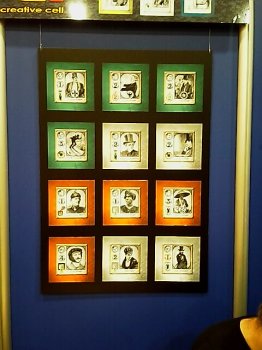 Phew, this game is not easy to enter, and it certainly has posed an interesting task to capture the rules within the frame of this short review. There actually are a few more minor twists to the game, but you should have gotten a general impression on how the game works. The author Folker Jung explained the game to my testing group, and this proved to be a quite efficient help since he pointed at a few of the strategies which the players actually may chose to win the game. So, on the one hand it is possible to specialise on hiring spies from one or two sections, using them for maximum advantage in their section's field of action. On the other hand, a player could constantly bid his secrets for grey spies, disabling him to receive coloured spies but getting him some of the slightly weaker grey spies at rather cheap prices. Eliminating or delaying the spies of other players, increasing other players secret-indicators and forcing them to capture Circle-members, or using spies for his own good - the players have a broad choice of possible actions which may lead to different ways to win the game every time it is played. And if a player falls far behing because his planning and plotting did not work out because of other spies intervening, it might still be worth to try to further the interests of the Circle in order to become the winner by having scored fewest Victory Points. Although the game does not seem to include a great depth in gameplay when you first look at the playing components spread out on the table, it is quite surprising what kinds of ideas can be found in the game. As you will have noticed, it is especially the Time Wheel which serves as the motor of the game, and I really liked the simulation of the time passing after the spies had acted. A player will have to think carefully when a spy should be used, since he will need some time to become ready for another action, but it is also possible to use powerful combinations of spies from different service sections to make great advances or cause dire losses to other players. The game is difficult since the players need to get familiar with the powers of the spies and it also needs to get used to develop a strategy, but once the players have fought the Circle one or twice they will be enthralled by the strategic options available. However, keeping the world from disaster takes time, and so the players should be willing to invest something around two hours when playing the game for the first times and a good amount of extra time for getting familiar with the rules. The game even includes full English rules, and it should not be underestimated just because its somewhat Spartan looks. So far, it is not available from distributors, but it can be ordered directly on the C4-website. And with this review, we have also reached the end of my convention reports from the SPIEL 2007. It's 3:00 AM once again, and as usual I will publish and notify the winners of the Prize-Draw in the next couple of days. However, having seen a good share of games at the con, I will once again award Kulkmann's Convention Hit ! This year, the decision proved to be rather hard, since I have quite a few games on my list which have left some quite good impressions with me. On the one hand I have The Circle and Tribun which I playtested today, both of them being rather nice strategy games with really intersting elements in their rules, on the other hand there is Kingsburg with a very smoothly running playing mechanism and Medievalia which, after getting the rules straight, proves to be a very easy to learn resource managment and battle game. I have decided against Kingsburg on the matter that direct player interaction could be higher (it is mostly done with blocking court members which other players then may not use on the same turn) and also because of the price. The game comes with a beautiful gameboard, but there are only very few cards and playing components included and the player mats actually are printed onto slightly hardened paper. That's not enough to justify a price of 40 Euros for the German edition and 50 Euros for other language versions. On these terms Medievalia is a much better choice, since it offers a higher entertainment value for much less money. However, both the detailed playing mechanisms both in Tribun and The Circle outclass the options available in Medievalia, and in the end I have dicided to give my special recommendation to The Circle
because the game offers a rather unique mechanism for simulating the playing time and also a variety of possible strategies which should encertain a high degree concerning its replay value. Tribun comes close behind, but considering the fact that The Circle was done by a newcomer I would like to award this really inventive first product.  Thanks to all of you for following me through the convention once again, and also thanks for all the positive comments you left in my guestbook! It's very important for me to see that me reports are finding a good echo out there, and this certainly helps keeping my eye open during these long nights of typing. If you have anything to add or comment on, please don't hesitate to send me an email!!! See you all again for the SPIEL 2008 next year!!! Frank Schulte-Kulkmann (signing off to get some sleep....) Previews of two games presented at EssenWell, you are a bit early for the convention reports, but do not worry! Once again, I am going to bring you full coverage from the SPIEL 2007, so stay tuned to the G@mebox in the weeks to come! However, for those of you who are really hungry for gaming news, I have some nice surprise. I received a few pre-convention review requests, and so this year I can start to review games even before the con has started! And here is the first review of a game to be released at Essen 07:
"Chang Cheng" from TENKIGAMES Okay, the pre-convention countdown continues, and once again I have looked towards Italy for another publisher which is going to bring a game to Essen. And And so, let us have a closer look at another game which is scheduled for the convention:
"Medievalia" from GIOCHIX If you want to have a peek at my coverage of previous conventions, follow these links:
Opening timesFrom thursday to saturday the convention is opened from 10 AM until 7 PM, on sunday from 10 AM to 6 PM. Travelling to the Messe EssenIf you arrive at Düsseldorf International Airport, it takes about 20 minutes to get to the Messe Essen by Cab. If you hire a car at Düsseldorf Airport, you go onto Autobahn A44 (blue signs), and at the next motorway crossing you go over to A52, direction Essen. Take Exit "Essen Rüttenscheid". You can also go by train to Essen Central Station. If arriving there, go to the basement and take the Subway U11 directly to the Messe Essen. If you want to arrange lodging at Essen, you best contact the Essen-tourism-center by phone 0049/(0)201/19433 or 0049/(0)201/88720-46 or -48. Perhaps they know where some Hotel-rooms are left... |
|
| |

Looking for the new games? Visit Funagain Games! |
|
|
| |
|
Kulkmann@aol.com
Copyright © 2007 Frank Schulte-Kulkmann, Essen, Germany | |